- Show search
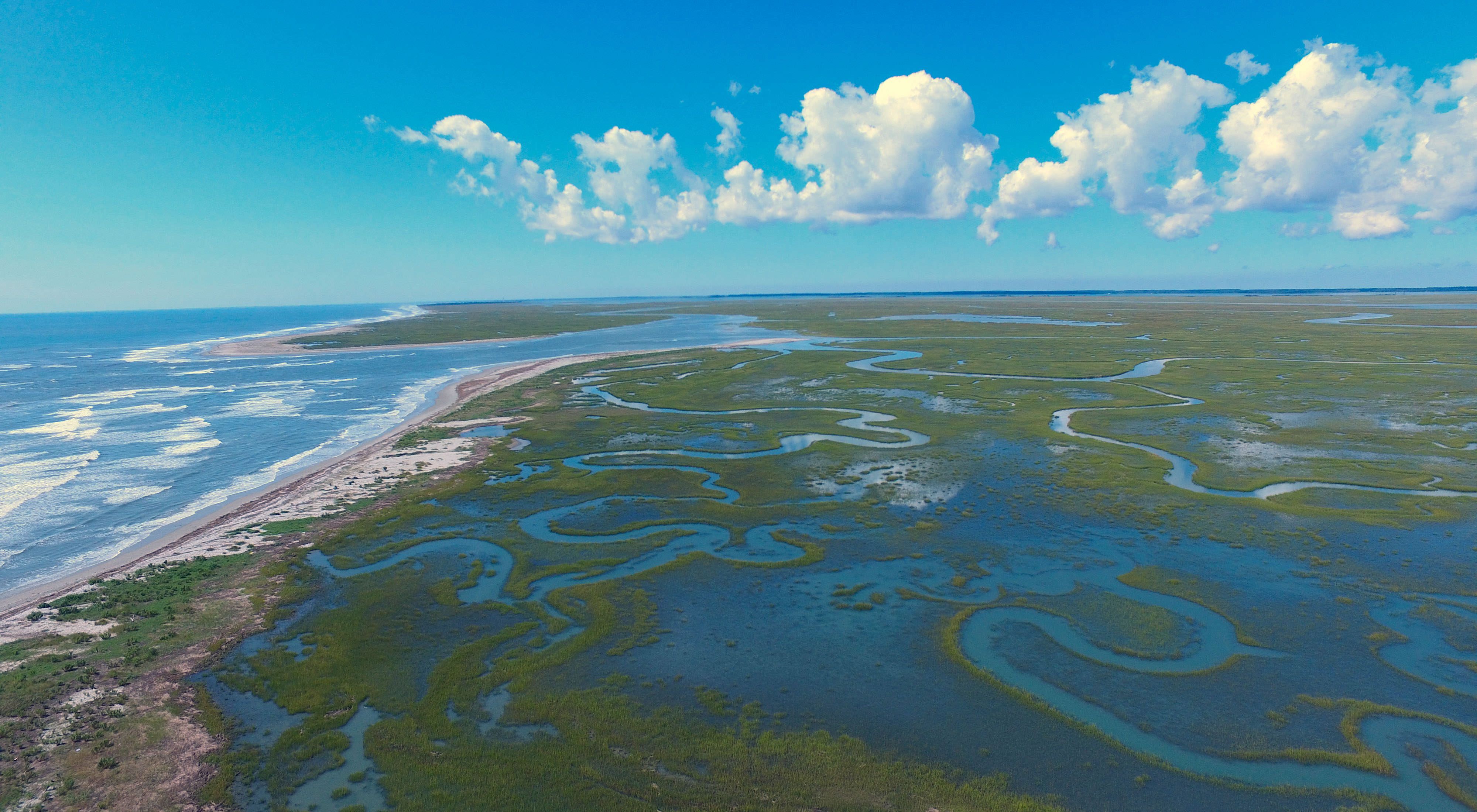
Perspectives

Five Reflections on the IPCC Climate Change Report
October 24, 2018
By Justin Adams, Executive Director, Tropical Forest Alliance
In response to last week’s release of the UN’s IPCC report on the climate, which warned that “unprecedented” changes were needed to slow or stop global warming beyond 1.5C pre-industrial period, it’s easy judging by the headlines and subsequent global response to perhaps give up or sink into despair. “Terrifying.” “Time to Wake Up.” “Final Call”. “Ten years to Act ” were just some of the headlines. Could this report, as shocking as it is, actually be the much-needed catalyst for action we’ve all been waiting for? Letting the dust settle a little on this powerful series of findings endorsed by all the world’s governments, these are my top five reflections.
Could this report actually be the much-needed catalyst for action we’ve all been waiting for?
1. We now have a better understanding that every fraction of a degree counts
The report shows that every fraction of a degree of warming matters. Continued rising temperatures will exact a huge toll on people, natural ecosystems and the economy. The IPCC concludes the world will likely reach 1.5°C above pre-industrial levels as soon as 2030. It notes that 20-40 percent of the global population lives in regions that have already experienced warming of more than 1.5°C in at least one season.
The primary way to limit warming to less than 1.5°C is to reduce greenhouse gas emissions—and eventually reach net-zero emissions. According to the report, to limit warming to 1.5°C with “no or limited overshoot,” net global CO 2 emissions need to fall by about 45 percent from 2010 levels by 2030 and reach net zero by around 2050.
The report puts it this way: “By 2100, global sea-level rise would be 10 cm lower with global warming of 1.5°C compared with 2°C. The likelihood of an Arctic Ocean free of sea ice in summer would be once per century with global warming of 1.5°C, compared with at least once per decade with 2°C. Coral reefs would decline by 70-90 percent with global warming of 1.5°C, whereas virtually all would be lost with 2°C.”
However, here is the kicker. Even with the pledged emission cuts under the Paris Agreement, the world is nowhere near achieving the volume of necessary cuts. To do so, we would need “rapid and far-reaching transitions” across the entire global economy, including changes in the way we source and use energy, how we use land and grow food, and what types and quantities of food and materials we consume.

The Science of Sustainability
We can limit climate change and allow for further human development—but only if we act soon. Explore our latest research
2. We have a better understanding of deep mitigation pathways—and nature is the ‘forgotten solution’ we need to reach 1.5°C
A series of reports that qualify and quantify the power of nature as a climate solution have also been released. The CLARA Alliance just released its report , suggesting that shifting from industrial crop and livestock production toward more ecological methods would make a major contribution towards reducing emissions, while also feeding people fairly and empowering the world’s smallholder farmers, particularly women. It points out that the 1.5 degree goal can be met without relying on planetary-scale land-use change like BECCS (Bioenergy with Carbon Capture Storage) for carbon removal.
Further huge emissions savings can be made if sections of society that enjoy high levels of meat consumption shifted to consuming fewer animal products, and to a more plant-based flexitarian diet. A “less and better” approach to food production would go a long way toward cutting emissions, the report says, while still feeding the world fairly. Taken together, ecosystem-based approaches and transformative changes in land and agriculture sectors could deliver 11 Gt CO2-eq per year in avoided emissions, and a further 10 Gt CO2-eq per year in carbon sequestered into the biosphere by 2050.
Furthermore, a study by The Nature Conservancy (TNC) and a group of other organizations published last year found that natural climate solutions like these could deliver a third of the required mitigation by 2030 to restrict global warming to 2 degrees. The key is that these natural solutions are affordable, actionable and scalable today . They do not involve technologies still under development with unknown costs. A forthcoming assessment on land use in the USA is also expected to show enormous potential.

3. It’s one system
Protecting and increasing tropical forest cover is vital, since these regions cool the air and are key to generating regional rainfall that supports food production. Yet commodities like beef, soy, timber and palm oil are currently responsible for over half of tropical forest loss. What we eat and use matters. Soil leads the way as a carbon sink and is among the cheapest methods with the greatest potential. The IPCC found that by 2050, soil carbon sequestration could remove between two and five gigatons of CO2 a year , at a cost ranging from less than $0 to $100 per ton. It also helps us grow our food.
4. Action and money are needed now
We need to talk about how to shift capital. As mentioned above, one reading of scenarios presented in the report to stay below 1.5 C of warming shows that we only have until around 2030 to achieve net-zero emissions globally. That's essentially tomorrow when we're talking about the pace of change required in a complex, dynamic systems like energy, food and financial markets.
Most organizations working along and together now recognize that to stop or slow global warming, we will have to increase current levels of ambition. Natural climate solutions, which have long been overlooked by the international community, will have to play a much bigger role. In effect that means governments and companies must set specific targets for natural climate solutions in their commitments under Paris.
It also means a ramp-up in finance: right now, the land sector only receives around 3% of public climate funding. That will have to be targeted to leverage the scale of the private sector if the transition on land is to be successful.

5. This is no longer just an ‘environmental story’
Time’s up. It's time to take action now or pay for it later – indeed, not much later if current climate trends are any indication. To get to 2 degrees Celsius or under, all these solutions require unprecedented efforts to cut fossil-fuel use in half in less than 15 years and eliminate their use almost entirely within 30 years. Long siloed, the conversation at least this month took on a new urgency. Climate change is no longer just a political story. The science is clear, the impacts too obvious, the potentially irreversible repercussions as well as deployable solutions imminent. Now it's a business story, a legal story and, increasingly, a story about the potential contribution of both technology and nature working alongside each other.
The good news is that the future hasn’t already been set in stone. Climate change is an inescapable present and future reality, but the point of the IPCC report is that there is still a chance to seize the best-case scenario rather than surrender to the worst. This December, Poland hosts the next UN governmental meeting, and the UN Secretary General has asked global leaders to meet with him at a special summit in New York in September next year, citing alarm by the paralysis of world leaders on what he called the "defining issue" of our time. Grave threat, or unmissable opportunity for movement and funding? There is still time to decide, although the window is narrowing rapidly.
Originally Posted on Nature4Climate October 17, 2018 View Original
Related Reading

There is a Forgotten Solution to Climate Change That We Must Invest In: Nature
We have forgotten the role nature can play in mitigating climate change.
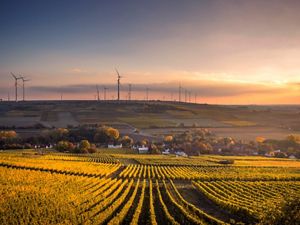
Climate Action from the Ground Up
There’s a groundswell of leadership on climate action happening at the local level.

Can a unified path for development and conservation lead to a better future?

45,000+ students realised their study abroad dream with us. Take the first step today
Here’s your new year gift, one app for all your, study abroad needs, start your journey, track your progress, grow with the community and so much more.

Verification Code
An OTP has been sent to your registered mobile no. Please verify

Thanks for your comment !
Our team will review it before it's shown to our readers.

Essay on Global Warming
- Updated on
- Apr 27, 2024

Being able to write an essay is an integral part of mastering any language. Essays form an integral part of many academic and scholastic exams like the SAT , and UPSC amongst many others. It is a crucial evaluative part of English proficiency tests as well like IELTS , TOEFL , etc. Major essays are meant to emphasize public issues of concern that can have significant consequences on the world. To understand the concept of Global Warming and its causes and effects, we must first examine the many factors that influence the planet’s temperature and what this implies for the world’s future. Here’s an unbiased look at the essay on Global Warming and other essential related topics.
Short Essay on Global Warming and Climate Change?
Since the industrial and scientific revolutions, Earth’s resources have been gradually depleted. Furthermore, the start of the world’s population’s exponential expansion is particularly hard on the environment. Simply put, as the population’s need for consumption grows, so does the use of natural resources , as well as the waste generated by that consumption.
Climate change has been one of the most significant long-term consequences of this. Climate change is more than just the rise or fall of global temperatures; it also affects rain cycles, wind patterns, cyclone frequencies, sea levels, and other factors. It has an impact on all major life groupings on the planet.
Also Read: World Population Day
What is Global Warming?
Global warming is the unusually rapid increase in Earth’s average surface temperature over the past century, primarily due to the greenhouse gases released by people burning fossil fuels . The greenhouse gases consist of methane, nitrous oxide, ozone, carbon dioxide, water vapour, and chlorofluorocarbons. The weather prediction has been becoming more complex with every passing year, with seasons more indistinguishable, and the general temperatures hotter.
The number of hurricanes, cyclones, droughts, floods, etc., has risen steadily since the onset of the 21st century. The supervillain behind all these changes is Global Warming. The name is quite self-explanatory; it means the rise in the temperature of the Earth.
Also Read: What is a Natural Disaster?
What are the Causes of Global Warming?
According to recent studies, many scientists believe the following are the primary four causes of global warming:
- Deforestation
- Greenhouse emissions
- Carbon emissions per capita
Extreme global warming is causing natural disasters , which can be seen all around us. One of the causes of global warming is the extreme release of greenhouse gases that become trapped on the earth’s surface, causing the temperature to rise. Similarly, volcanoes contribute to global warming by spewing excessive CO2 into the atmosphere.
The increase in population is one of the major causes of Global Warming. This increase in population also leads to increased air pollution . Automobiles emit a lot of CO2, which remains in the atmosphere. This increase in population is also causing deforestation, which contributes to global warming.
The earth’s surface emits energy into the atmosphere in the form of heat, keeping the balance with the incoming energy. Global warming depletes the ozone layer, bringing about the end of the world. There is a clear indication that increased global warming will result in the extinction of all life on Earth’s surface.
Also Read: Land, Soil, Water, Natural Vegetation, and Wildlife Resources
Solutions for Global Warming
Of course, industries and multinational conglomerates emit more carbon than the average citizen. Nonetheless, activism and community effort are the only viable ways to slow the worsening effects of global warming. Furthermore, at the state or government level, world leaders must develop concrete plans and step-by-step programmes to ensure that no further harm is done to the environment in general.
Although we are almost too late to slow the rate of global warming, finding the right solution is critical. Everyone, from individuals to governments, must work together to find a solution to Global Warming. Some of the factors to consider are pollution control, population growth, and the use of natural resources.
One very important contribution you can make is to reduce your use of plastic. Plastic is the primary cause of global warming, and recycling it takes years. Another factor to consider is deforestation, which will aid in the control of global warming. More tree planting should be encouraged to green the environment. Certain rules should also govern industrialization. Building industries in green zones that affect plants and species should be prohibited.
Also Read: Essay on Pollution
Effects of Global Warming
Global warming is a real problem that many people want to disprove to gain political advantage. However, as global citizens, we must ensure that only the truth is presented in the media.
This decade has seen a significant impact from global warming. The two most common phenomena observed are glacier retreat and arctic shrinkage. Glaciers are rapidly melting. These are clear manifestations of climate change.
Another significant effect of global warming is the rise in sea level. Flooding is occurring in low-lying areas as a result of sea-level rise. Many countries have experienced extreme weather conditions. Every year, we have unusually heavy rain, extreme heat and cold, wildfires, and other natural disasters.
Similarly, as global warming continues, marine life is being severely impacted. This is causing the extinction of marine species as well as other problems. Furthermore, changes are expected in coral reefs, which will face extinction in the coming years. These effects will intensify in the coming years, effectively halting species expansion. Furthermore, humans will eventually feel the negative effects of Global Warming.
Also Read: Concept of Sustainable Development
Sample Essays on Global Warming
Here are some sample essays on Global Warming:
Essay on Global Warming Paragraph in 100 – 150 words
Global Warming is caused by the increase of carbon dioxide levels in the earth’s atmosphere and is a result of human activities that have been causing harm to our environment for the past few centuries now. Global Warming is something that can’t be ignored and steps have to be taken to tackle the situation globally. The average temperature is constantly rising by 1.5 degrees Celsius over the last few years.
The best method to prevent future damage to the earth, cutting down more forests should be banned and Afforestation should be encouraged. Start by planting trees near your homes and offices, participate in events, and teach the importance of planting trees. It is impossible to undo the damage but it is possible to stop further harm.
Also Read: Social Forestry
Essay on Global Warming in 250 Words
Over a long period, it is observed that the temperature of the earth is increasing. This affected wildlife, animals, humans, and every living organism on earth. Glaciers have been melting, and many countries have started water shortages, flooding, and erosion and all this is because of global warming.
No one can be blamed for global warming except for humans. Human activities such as gases released from power plants, transportation, and deforestation have increased gases such as carbon dioxide, CFCs, and other pollutants in the earth’s atmosphere. The main question is how can we control the current situation and build a better world for future generations. It starts with little steps by every individual.
Start using cloth bags made from sustainable materials for all shopping purposes, instead of using high-watt lights use energy-efficient bulbs, switch off the electricity, don’t waste water, abolish deforestation and encourage planting more trees. Shift the use of energy from petroleum or other fossil fuels to wind and solar energy. Instead of throwing out the old clothes donate them to someone so that it is recycled.
Donate old books, don’t waste paper. Above all, spread awareness about global warming. Every little thing a person does towards saving the earth will contribute in big or small amounts. We must learn that 1% effort is better than no effort. Pledge to take care of Mother Nature and speak up about global warming.
Also Read: Types of Water Pollution
Essay on Global Warming in 500 Words
Global warming isn’t a prediction, it is happening! A person denying it or unaware of it is in the most simple terms complicit. Do we have another planet to live on? Unfortunately, we have been bestowed with this one planet only that can sustain life yet over the years we have turned a blind eye to the plight it is in. Global warming is not an abstract concept but a global phenomenon occurring ever so slowly even at this moment. Global Warming is a phenomenon that is occurring every minute resulting in a gradual increase in the Earth’s overall climate. Brought about by greenhouse gases that trap the solar radiation in the atmosphere, global warming can change the entire map of the earth, displacing areas, flooding many countries, and destroying multiple lifeforms. Extreme weather is a direct consequence of global warming but it is not an exhaustive consequence. There are virtually limitless effects of global warming which are all harmful to life on earth. The sea level is increasing by 0.12 inches per year worldwide. This is happening because of the melting of polar ice caps because of global warming. This has increased the frequency of floods in many lowland areas and has caused damage to coral reefs. The Arctic is one of the worst-hit areas affected by global warming. Air quality has been adversely affected and the acidity of the seawater has also increased causing severe damage to marine life forms. Severe natural disasters are brought about by global warming which has had dire effects on life and property. As long as mankind produces greenhouse gases, global warming will continue to accelerate. The consequences are felt at a much smaller scale which will increase to become drastic shortly. The power to save the day lies in the hands of humans, the need is to seize the day. Energy consumption should be reduced on an individual basis. Fuel-efficient cars and other electronics should be encouraged to reduce the wastage of energy sources. This will also improve air quality and reduce the concentration of greenhouse gases in the atmosphere. Global warming is an evil that can only be defeated when fought together. It is better late than never. If we all take steps today, we will have a much brighter future tomorrow. Global warming is the bane of our existence and various policies have come up worldwide to fight it but that is not enough. The actual difference is made when we work at an individual level to fight it. Understanding its import now is crucial before it becomes an irrevocable mistake. Exterminating global warming is of utmost importance and each one of us is as responsible for it as the next.
Also Read: Essay on Library: 100, 200 and 250 Words
Essay on Global Warming UPSC
Always hear about global warming everywhere, but do we know what it is? The evil of the worst form, global warming is a phenomenon that can affect life more fatally. Global warming refers to the increase in the earth’s temperature as a result of various human activities. The planet is gradually getting hotter and threatening the existence of lifeforms on it. Despite being relentlessly studied and researched, global warming for the majority of the population remains an abstract concept of science. It is this concept that over the years has culminated in making global warming a stark reality and not a concept covered in books. Global warming is not caused by one sole reason that can be curbed. Multifarious factors cause global warming most of which are a part of an individual’s daily existence. Burning of fuels for cooking, in vehicles, and for other conventional uses, a large amount of greenhouse gases like carbon dioxide, and methane amongst many others is produced which accelerates global warming. Rampant deforestation also results in global warming as lesser green cover results in an increased presence of carbon dioxide in the atmosphere which is a greenhouse gas. Finding a solution to global warming is of immediate importance. Global warming is a phenomenon that has to be fought unitedly. Planting more trees can be the first step that can be taken toward warding off the severe consequences of global warming. Increasing the green cover will result in regulating the carbon cycle. There should be a shift from using nonrenewable energy to renewable energy such as wind or solar energy which causes less pollution and thereby hinder the acceleration of global warming. Reducing energy needs at an individual level and not wasting energy in any form is the most important step to be taken against global warming. The warning bells are tolling to awaken us from the deep slumber of complacency we have slipped into. Humans can fight against nature and it is high time we acknowledged that. With all our scientific progress and technological inventions, fighting off the negative effects of global warming is implausible. We have to remember that we do not inherit the earth from our ancestors but borrow it from our future generations and the responsibility lies on our shoulders to bequeath them a healthy planet for life to exist.
Also Read: Essay on Disaster Management
Climate Change and Global Warming Essay
Global Warming and Climate Change are two sides of the same coin. Both are interrelated with each other and are two issues of major concern worldwide. Greenhouse gases released such as carbon dioxide, CFCs, and other pollutants in the earth’s atmosphere cause Global Warming which leads to climate change. Black holes have started to form in the ozone layer that protects the earth from harmful ultraviolet rays.
Human activities have created climate change and global warming. Industrial waste and fumes are the major contributors to global warming.
Another factor affecting is the burning of fossil fuels, deforestation and also one of the reasons for climate change. Global warming has resulted in shrinking mountain glaciers in Antarctica, Greenland, and the Arctic and causing climate change. Switching from the use of fossil fuels to energy sources like wind and solar.
When buying any electronic appliance buy the best quality with energy savings stars. Don’t waste water and encourage rainwater harvesting in your community.
Also Read: Essay on Air Pollution
Tips to Write an Essay
Writing an effective essay needs skills that few people possess and even fewer know how to implement. While writing an essay can be an assiduous task that can be unnerving at times, some key pointers can be inculcated to draft a successful essay. These involve focusing on the structure of the essay, planning it out well, and emphasizing crucial details.
Mentioned below are some pointers that can help you write better structure and more thoughtful essays that will get across to your readers:
- Prepare an outline for the essay to ensure continuity and relevance and no break in the structure of the essay
- Decide on a thesis statement that will form the basis of your essay. It will be the point of your essay and help readers understand your contention
- Follow the structure of an introduction, a detailed body followed by a conclusion so that the readers can comprehend the essay in a particular manner without any dissonance.
- Make your beginning catchy and include solutions in your conclusion to make the essay insightful and lucrative to read
- Reread before putting it out and add your flair to the essay to make it more personal and thereby unique and intriguing for readers
Also Read: I Love My India Essay: 100 and 500+ Words in English for School Students
Ans. Both natural and man-made factors contribute to global warming. The natural one also contains methane gas, volcanic eruptions, and greenhouse gases. Deforestation, mining, livestock raising, burning fossil fuels, and other man-made causes are next.
Ans. The government and the general public can work together to stop global warming. Trees must be planted more often, and deforestation must be prohibited. Auto usage needs to be curbed, and recycling needs to be promoted.
Ans. Switching to renewable energy sources , adopting sustainable farming, transportation, and energy methods, and conserving water and other natural resources.
Relevant Blogs
For more information on such interesting topics, visit our essay writing page and follow Leverage Edu.
Digvijay Singh
Having 2+ years of experience in educational content writing, withholding a Bachelor's in Physical Education and Sports Science and a strong interest in writing educational content for students enrolled in domestic and foreign study abroad programmes. I believe in offering a distinct viewpoint to the table, to help students deal with the complexities of both domestic and foreign educational systems. Through engaging storytelling and insightful analysis, I aim to inspire my readers to embark on their educational journeys, whether abroad or at home, and to make the most of every learning opportunity that comes their way.
Leave a Reply Cancel reply
Save my name, email, and website in this browser for the next time I comment.
Contact no. *
This was really a good essay on global warming… There has been used many unic words..and I really liked it!!!Seriously I had been looking for a essay about Global warming just like this…
Thank you for the comment!
I want to learn how to write essay writing so I joined this page.This page is very useful for everyone.
Hi, we are glad that we could help you to write essays. We have a beginner’s guide to write essays ( https://leverageedu.com/blog/essay-writing/ ) and we think this might help you.
It is not good , to have global warming in our earth .So we all have to afforestation program on all the world.
thank you so much
Very educative , helpful and it is really going to strength my English knowledge to structure my essay in future
Thank you for the comment, please follow our newsletter to get more insights on studying abroad and exams!
Global warming is the increase in 𝓽𝓱𝓮 ᴀᴠᴇʀᴀɢᴇ ᴛᴇᴍᴘᴇʀᴀᴛᴜʀᴇs ᴏғ ᴇᴀʀᴛʜ🌎 ᴀᴛᴍᴏsᴘʜᴇʀᴇ

Leaving already?
8 Universities with higher ROI than IITs and IIMs
Grab this one-time opportunity to download this ebook
Connect With Us
45,000+ students realised their study abroad dream with us. take the first step today..

Resend OTP in

Need help with?
Study abroad.
UK, Canada, US & More
IELTS, GRE, GMAT & More
Scholarship, Loans & Forex
Country Preference
New Zealand
Which English test are you planning to take?
Which academic test are you planning to take.
Not Sure yet
When are you planning to take the exam?
Already booked my exam slot
Within 2 Months
Want to learn about the test
Which Degree do you wish to pursue?
When do you want to start studying abroad.
September 2024
January 2025
What is your budget to study abroad?

How would you describe this article ?
Please rate this article
We would like to hear more.
Suggestions or feedback?
MIT News | Massachusetts Institute of Technology
- Machine learning
- Social justice
- Black holes
- Classes and programs
Departments
- Aeronautics and Astronautics
- Brain and Cognitive Sciences
- Architecture
- Political Science
- Mechanical Engineering
Centers, Labs, & Programs
- Abdul Latif Jameel Poverty Action Lab (J-PAL)
- Picower Institute for Learning and Memory
- Lincoln Laboratory
- School of Architecture + Planning
- School of Engineering
- School of Humanities, Arts, and Social Sciences
- Sloan School of Management
- School of Science
- MIT Schwarzman College of Computing
Study: Reflecting sunlight to cool the planet will cause other global changes
Press contact :, media download.
*Terms of Use:
Images for download on the MIT News office website are made available to non-commercial entities, press and the general public under a Creative Commons Attribution Non-Commercial No Derivatives license . You may not alter the images provided, other than to crop them to size. A credit line must be used when reproducing images; if one is not provided below, credit the images to "MIT."
Previous image Next image
How can the world combat the continued rise in global temperatures? How about shading the Earth from a portion of the sun’s heat by injecting the stratosphere with reflective aerosols? After all, volcanoes do essentially the same thing, albeit in short, dramatic bursts: When a Vesuvius erupts, it blasts fine ash into the atmosphere, where the particles can linger as a kind of cloud cover, reflecting solar radiation back into space and temporarily cooling the planet.
Some researchers are exploring proposals to engineer similar effects, for example by launching reflective aerosols into the stratosphere — via planes, balloons, and even blimps — in order to block the sun’s heat and counteract global warming. But such solar geoengineering schemes, as they are known, could have other long-lasting effects on the climate.
Now scientists at MIT have found that solar geoengineering would significantly change extratropical storm tracks — the zones in the middle and high latitudes where storms form year-round and are steered by the jet stream across the oceans and land. Extratropical storm tracks give rise to extratropical cyclones, and not their tropical cousins, hurricanes. The strength of extratropical storm tracks determines the severity and frequency of storms such as nor’easters in the United States.
The team considered an idealized scenario in which solar radiation was reflected enough to offset the warming that would occur if carbon dioxide were to quadruple in concentration. In a number of global climate models under this scenario, the strength of storm tracks in both the northern and southern hemispheres weakened significantly in response.
Weakened storm tracks would mean less powerful winter storms, but the team cautions that weaker storm tracks also lead to stagnant conditions, particularly in summer, and less wind to clear away air pollution. Changes in winds could also affect the circulation of ocean waters and, in turn, the stability of ice sheets.
“About half the world’s population lives in the extratropical regions where storm tracks dominate weather,” says Charles Gertler, a graduate student in MIT’s Department of Earth, Atmospheric and Planetary Sciences (EAPS). “Our results show that solar geoengineering will not simply reverse climate change. Instead, it has the potential itself to induce novel changes in climate.”
Gertler and his colleagues have published their results this week in the journal Geophysical Research Letters . Co-authors include EAPS Professor Paul O’Gorman, along with Ben Kravitz of Indiana University, John Moore of Beijing Normal University, Steven Phipps of the University of Tasmania, and Shingo Watanabe of the Japan Agency for Marine-Earth Science and Technology
A not-so-sunny picture
Scientists have previously modeled what Earth’s climate might look like if solar geoengineering scenarios were to play out on a global scale, with mixed results. On the one hand, spraying aerosols into the stratosphere would reduce incoming solar heat and, to a degree, counteract the warming caused by carbon dioxide emissions. On the other hand, such cooling of the planet would not prevent other greenhouse gas-induced effects such as regional reductions in rainfall and ocean acidification.
There have also been signs that intentionally reducing solar radiation would shrink the temperature difference between the Earth’s equator and poles or, in climate parlance, weaken the planet’s meridional temperature gradient, cooling the equator while the poles continue to warm. This last consequence was especially intriguing to Gertler and O’Gorman.
“Storm tracks feed off of meridional temperature gradients, and storm tracks are interesting because they help us to understand weather extremes,” Gertler says. “So we were interested in how geoengineering affects storm tracks.”
The team looked at how extratropical storm tracks might change under a scenario of solar geoengineering known to climate scientists as experiment G1 of the Geoengineering Model Intercomparison Project (GeoMIP), a project that provides various geoengineering scenarios for scientists to run on climate models to assess their various climate effects.
The G1 experiment assumes an idealized scenario in which a solar geoengineering scheme blocks enough solar radiation to counterbalance the warming that would occur if carbon dioxide concentrations were to quadruple.
The researchers used results from various climate models run forward in time under the conditions of the G1 experiment. They also used results from a more sophisticated geoengineering scenario with doubling of carbon dioxide concentrations and aerosols injected into the stratosphere at more than one latitude. In each model they recorded the day-to-day change in air pressure at sea level pressure at various locations along the storm tracks. These changes reflect the passage of storms and measure a storm track’s energy.
“If we look at the variance in sea level pressure, we have a sense of how often and how strongly cyclones pass over each area,” Gertler explains. “We then average the variance across the whole extratropical region, to get an average value of storm track strength for the northern and southern hemispheres.”
An imperfect counterbalance
Their results, across climate models, showed that solar geoengineering would weaken storm tracks in both Northern and Southern hemispheres. Depending on the scenario they considered, the storm track in the Northern Hemisphere would be 5 to 17 percent weaker than it is today.
“A weakened storm track, in both hemispheres, would mean weaker winter storms but also lead to more stagnant weather, which could affect heat waves,” Gertler says. “Across all seasons, this could affect ventilation of air pollution. It also may contribute to a weakening of the hydrological cycle, with regional reductions in rainfall. These are not good changes, compared to a baseline climate that we are used to.”
The researchers were curious to see how the same storm tracks would respond to just global warming alone, without the addition of social geoengineering, so they ran the climate models again under several warming-only scenarios. Surprisingly, they found that, in the northern hemisphere, global warming would also weaken storm tracks, by the same magnitude as with the addition of solar geoengineering. This suggests solar geoengineering, and efforts to cool the Earth by reducing incoming heat, would not do much to alter global warming’s effects, at least on storm tracks — a puzzling outcome that the researchers are unsure how to explain.
In the Southern Hemisphere, there is a slightly different story. They found that global warming alone would strengthen storm tracks there, whereas the addition of solar geoengineering would prevent this strengthening, and even further, would weaken the storm tracks there.
“In the Southern Hemisphere, winds drive ocean circulation, which in turn could affect uptake of carbon dioxide, and the stability of the Antarctic ice sheet,” O’Gorman adds. “So how storm tracks change over the Southern Hemisphere is quite important.”
The team also observed that the weakening of storm tracks was strongly correlated with changes in temperature and humidity. Specifically, the climate models showed that in response to reduced incoming solar radiation, the equator cooled significantly as the poles continued to warm. This reduced temperature gradient appears to be sufficient to explain the weakening storm tracks — a result that the group is the first to demonstrate.
“This work highlights that solar geoengineering is not reversing climate change, but is substituting one unprecedented climate state for another,” Gertler says. “Reflecting sunlight isn’t a perfect counterbalance to the greenhouse effect.”
Adds O’Gorman: “There are multiple reasons to avoid doing this, and instead to favor reducing emissions of CO 2 and other greenhouse gases.”
This research was funded, in part, by the National Science Foundation, NASA, and the Industry and Foundation sponsors of the MIT Joint Program on the Science and Policy of Global Change.
Share this news article on:
Press mentions, popular mechanics.
Popular Mechanics reporter Caroline Delbert writes that a study by MIT researchers finds that solar geoengineering efforts aimed at cooling the planet would change extratropical storm tracks. “The scientists discovered an amount of aerosol coverage required to offset that much more carbon dioxide would alter the storm tracks in both hemispheres and around the world,” says Delbert.
Previous item Next item
Related Links
- Paper: “Weakening of the extratropical storm tracks in solar geoengineering scenarios.”
- Paul O’Gorman
- Charles Gertler
- Department of Earth, Atmospheric and Planetary Sciences
Related Topics
- Climate change
- Earth and atmospheric sciences
- Environment
- National Science Foundation (NSF)
Related Articles
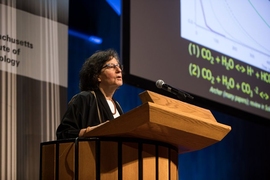
Experts urge “full speed ahead” on climate action
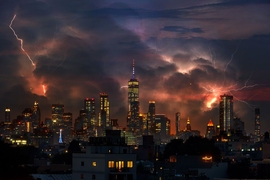
Climate change makes summer weather stormier yet more stagnant
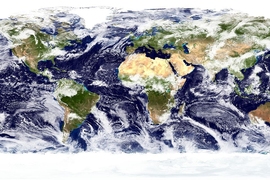
3Q: Machine learning and climate modeling
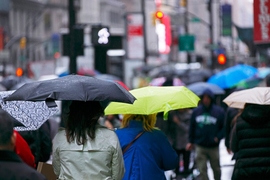
Varied increases in extreme rainfall with global warming
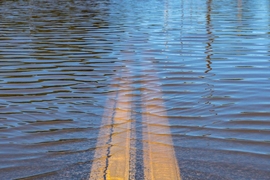
Study finds more extreme storms ahead for California
More mit news.

Scientists identify mechanism behind drug resistance in malaria parasite
Read full story →
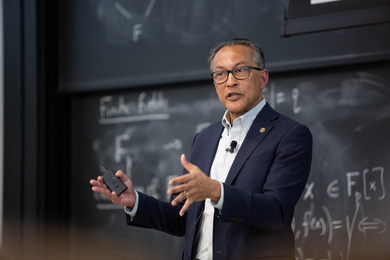
Getting to systemic sustainability
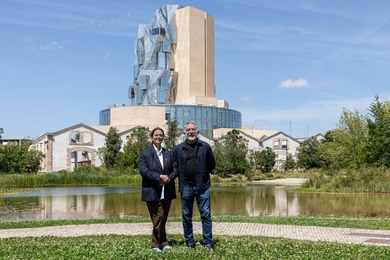
New MIT-LUMA Lab created to address climate challenges in the Mediterranean region

MIT Press releases Direct to Open impact report


Modeling the threat of nuclear war

Modular, scalable hardware architecture for a quantum computer
- More news on MIT News homepage →
Massachusetts Institute of Technology 77 Massachusetts Avenue, Cambridge, MA, USA
- Map (opens in new window)
- Events (opens in new window)
- People (opens in new window)
- Careers (opens in new window)
- Accessibility
- Social Media Hub
- MIT on Facebook
- MIT on YouTube
- MIT on Instagram

Ask NASA Climate
Ask nasa climate | december 10, 2011, 16:00 pst, conclusions and reflections, eleventh-hour agreement.

By Dr. Erika Podest, NASA Jet Propulsion Laboratory From the UN conference on climate change, Durban, South Africa

It is not until the eleventh hour — on Sunday at 6:00 am — that negotiations come to a close. An agreement has been made to develop a roadmap towards a new legally binding treaty by 2015, which would come into force in 2020. In addition, the decision has been made to adopt a second commitment period on the Kyoto Protocol — the only global pact that enforces carbon cuts — producing a five-to-seven-year extension of the current protocol, which was set to expire in 2012.
In addition, the “Green Climate Fund” was launched, which is intended to channel money to developing countries to help with their mitigation and adaptation efforts. However, it is unclear where the funding will come from. A second factor that is important to developing countries is technology transfer, and it was agreed that a technology mechanism would be fully operational by 2012 to “promote and enhance the research, development and deployment and diffusion of environmentally-sound technologies for mitigation and adaptation in developing countries.”
The REDD+ (Reducing Emissions from Deforestation and Forest Degradation) program, a collaborative effort between countries to reduce heat-trapping carbon emissions from deforestation and forest degradation, has probably been the biggest success story. Though agreements are in place, there are still many details to be worked out such as reference emissions levels, validation and funding, but at least there is a path forward for further discussions on fleshing out those details.

Looking back, this conference is probably the most important climate change gathering of our time with the whole world represented at COP17. At the very least, I would describe it as an explosion of thoughts — with the main concerns across the board being food security, water shortage, loss of biodiversity, population displacement and an increase of climate change refugees, ecological degradation, human well-being, planetary thresholds, climate, energy, governance across scales, and poverty alleviation.
My overall feeling is of awkward content that something happened (given the alternative) but also of great disappointment that more tangible results were not reached and that there is a lack of understanding behind the sense of urgency about climate change. No obligation for any nation to reduce greenhouse gas emissions until 2020 is not good enough, and that is of course, assuming that future UN deliberations flow smoothly and a global deal is reached with binding commitments. My concern is that by the time politics finally reaches a consensus to limit climate change, the climate change train will already have left the station.
Though the whole process is clearly far from perfect, it is unfortunately the only mechanism in place that rallies the international community towards addressing the effects of climate change. Ultimately, it is the scientific community that must deliver to society what we know about climate change and the risks humanity is facing in the short- and long-term. Even though I am disappointed that results from the negotiations were not more forthcoming, I leave encouraged knowing that I and the NASA community help provide the latest scientific evidence for a comprehensive update of our knowledge of Earth systems and the pressures they are under. It is this science that sets the stage for meetings like this one in South Africa and NASA, through its capability to study Earth from space, is uniquely positioned to help understand and monitor processes at national, regional, and global scales in unprecedented ways.
Even though my week was absorbed with COP17, I would not do this blog justice without mention of Durban, a relaxed and beautiful beachside city of three million people. It was obvious that South Africa and the city of Durban went to great efforts to host the conference. I was impressed by how well the event was organized and how well the city hosted and welcomed COP17 participants. Durban’s most precious asset is its people, cheerful, helpful and always sharing their warm smiles.
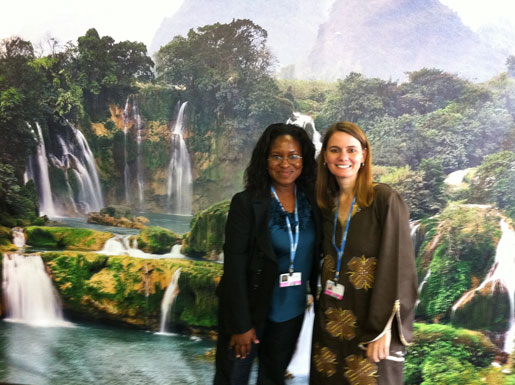
Finally, I am very grateful to have had this opportunity and I am particularly thankful to Jack Kaye and Duane Waliser for making it possible. I am also very grateful to Riley Duren and Tony Freeman for their advice and guidance, to Winnie Humberson for helping with logistics and preparation, to Eric Sokolowsky for being the whizz behind the Hyperwall, and to Amber Jenkins for being the magician behind this blog. A special thanks to the very friendly and professional staff from the U.S. State Department. Last but not least, to all of you who have followed my blog entries, thanks for reading!
Erika Podest is a scientist with the Water and Carbon Cycles Group at NASA’s Jet Propulsion Laboratory, and a Visiting Associate Researcher in the Joint Institute for Regional Earth System Science and Engineering (JIFRESSE) at UCLA. She focuses on using space satellites to monitor wetland ecosystems and seasonal freeze/thaw dynamics in the northern high latitudes of the globe, and improving our understanding of Earth’s water and carbon cycles and resources. Erika also leads a project that uses satellite data to study the palm swamp wetlands of the Amazon rainforest in order to better understand their contribution to the global carbon budget.
Our websites may use cookies to personalize and enhance your experience. By continuing without changing your cookie settings, you agree to this collection. For more information, please see our University Websites Privacy Notice .
Institute of the Environment
Office of Sustainability
Intern reflection essay: climate change inequality.
Last summer I studied abroad in Iceland. A country at the forefront of renewable energy, Iceland has the potential to be a global leader in sustainability. Its energy is almost entirely powered from geothermal and hydroelectric and thus it is capable of an exceptionally small carbon footprint. However, there is no drive for this among the Icelandic people. Lights are kept on throughout the daytime and cars are driven for errands just down the street. This contrasts remarkably with an earlier visit I made to Peru. The Peruvians lack many of the resources we take for granted in the United States and yet the environmental devastation they live within—littered streets, polluted air, and dirty water—causes no alarm among its citizens.
There are three dimensions to sustainability: social, economic, and environmental. Strong sustainability requires a balance between these three pillars—without economic stability, the government cannot implement environmental regulations and cannot provide the environmental education necessary to create a “green” movement among its people. The environmental degradation in Peru is largely due to the government’s lack of action. It is the government’s responsibility to provide its people safe, clean resources. Unfortunately, environmental law in Peru is not well enforced. Additionally, Peru has not prioritized developing renewable energy resources (although recently there has been a push for increased solar energy – hopefully that marks a turning point for Peru). And so I experienced countries at very opposite sides of a sustainability spectrum: one which economically cannot give the attention to environmental awareness that is warranted by the pressing reality of climate change and yet needs it sincerely, and another that is privileged with all that is required of an ecologically conscience nation and without the motivation to push for it among the people and culture.
After travelling to both of these beautiful countries I found myself very frustrated. Climate change looms on the horizon and the consequences of a warming planet are reason for great concern. The extent of climate change is not fully understood but what has been acknowledged is that the amplified rate at which it is occurring can be attributed to anthropogenic behavior. And this is not spread uniformly throughout the globe. Wealthy nations are contributing greatly to greenhouse gas emissions yet it will not be these same countries that most severely feel the threat of climate change. And what is even more upsetting is that the developing nations that will suffer the greatest because they do not have the economic strength and political stability to combat global warming are also mostly unaware of the dangers to come because there are many more pressing issues to confront such as inadequate food and poverty. So if the disparity between developed and developing nations was not already distressingly thick, climate change will surely broaden it further.
It is therefore the responsibility of countries such as the United States, who have the finances and the technologies, to lead our planet to a more sustainable future. The carbon emissions released by the United States does not solely affect our own citizens. It is a global crisis and so every car we drive, every coal power plant we construct, every long shower we take, and every technological device we keep plugged in is slowly yet catastrophically warming the entire planet. So, what should we do to reduce the climate change inequality that plagues our world? It starts at a local level. It requires cooperation and collaboration between leaders, businesses, and residents of a community and it demands environmental education.
Additionally, climate change inequality is not just found on the global scale. Even within the United States itself this disproportion is present. There are coastal cities at risk of flooding from sea level increase and yet they are not any more responsible for greenhouse gas emissions than the nation’s interior cities. Even on the micro scale this disparity is felt where industrial establishments directs emissions towards poverty stricken neighborhoods who cannot afford to fight this discrimation. UConn is committed to doing its part to help these efforts. In 2006 a co-generation plant was constructed to replace the previously used oil-fired utility. The co-gen burns natural gas, a cleaner fuel than oil and coal, and thus capable of reducing carbon dioxide emissions by up to 300,000 tons each year. It captures and utilizes steam to prevent efficiency loss. In 2008 former President Hogan signed the American College and University Presidents Climate Commitment (ACUPCC). This committed the university to carbon neutrality by 2050. The co-gen plant is just one of many technologies implemented by UConn to help assist in its mission towards carbon neutrality. UConn also has a fuel cell at the Depot campus, a bike and car sharing program, a reclaimed water facility, and much more.
But change cannot solely be acquired through better infrastructure and technology. We must demand a difference. This requires the voices of UConn’s students, staff, and faculty. It necessitates a new university culture that is eco-conscience and environmentally aware. UConn has many sustainability related courses and research opportunities. It has clubs and events that allow student participation. And it has many individuals who care greatly about playing their role in environmental stewardship. UConn is forging a path. It is setting precedence for universities throughout the country and throughout the globe. UConn is a leader in sustainability and is challenging the fight against climate change inequality.
– Emily
ENCYCLOPEDIC ENTRY
Global warming.
The causes, effects, and complexities of global warming are important to understand so that we can fight for the health of our planet.
Earth Science, Climatology
Tennessee Power Plant
Ash spews from a coal-fueled power plant in New Johnsonville, Tennessee, United States.
Photograph by Emory Kristof/ National Geographic

Global warming is the long-term warming of the planet’s overall temperature. Though this warming trend has been going on for a long time, its pace has significantly increased in the last hundred years due to the burning of fossil fuels . As the human population has increased, so has the volume of fossil fuels burned. Fossil fuels include coal, oil, and natural gas, and burning them causes what is known as the “greenhouse effect” in Earth’s atmosphere.
The greenhouse effect is when the sun’s rays penetrate the atmosphere, but when that heat is reflected off the surface cannot escape back into space. Gases produced by the burning of fossil fuels prevent the heat from leaving the atmosphere. These greenhouse gasses are carbon dioxide , chlorofluorocarbons, water vapor , methane , and nitrous oxide . The excess heat in the atmosphere has caused the average global temperature to rise overtime, otherwise known as global warming.
Global warming has presented another issue called climate change. Sometimes these phrases are used interchangeably, however, they are different. Climate change refers to changes in weather patterns and growing seasons around the world. It also refers to sea level rise caused by the expansion of warmer seas and melting ice sheets and glaciers . Global warming causes climate change, which poses a serious threat to life on Earth in the forms of widespread flooding and extreme weather. Scientists continue to study global warming and its impact on Earth.
Media Credits
The audio, illustrations, photos, and videos are credited beneath the media asset, except for promotional images, which generally link to another page that contains the media credit. The Rights Holder for media is the person or group credited.
Production Managers
Program specialists, last updated.
February 21, 2024
User Permissions
For information on user permissions, please read our Terms of Service. If you have questions about how to cite anything on our website in your project or classroom presentation, please contact your teacher. They will best know the preferred format. When you reach out to them, you will need the page title, URL, and the date you accessed the resource.
If a media asset is downloadable, a download button appears in the corner of the media viewer. If no button appears, you cannot download or save the media.
Text on this page is printable and can be used according to our Terms of Service .
Interactives
Any interactives on this page can only be played while you are visiting our website. You cannot download interactives.
Related Resources
News from the Columbia Climate School
Six Tough Questions About Climate Change

Whenever the focus is on climate change, as it is right now at the Paris climate conference , tough questions are asked concerning the costs of cutting carbon emissions, the feasibility of transitioning to renewable energy, and whether it’s already too late to do anything about climate change. We posed these questions to Laura Segafredo , manager for the Deep Decarbonization Pathways Project . The decarbonization project comprises energy research teams from 16 of the world’s biggest greenhouse gas emitting countries that are developing concrete strategies to reduce emissions in their countries. The Deep Decarbonization Pathways Project is an initiative of the Sustainable Development Solutions Network .
- Will the actions we take today be enough to forestall the direct impacts of climate change? Or is it too little too late?
There is still time and room for limiting climate change within the 2˚C limit that scientists consider relatively safe, and that countries endorsed in Copenhagen and Cancun. But clearly the window is closing quickly. I think that the most important message is that we need to start really, really soon, putting the world on a trajectory of stabilizing and reducing emissions. The temperature change has a direct relationship with the cumulative amount of emissions that are in the atmosphere, so the more we keep emitting at the pace that we are emitting today, the more steeply we will have to go on a downward trajectory and the more expensive it will be.
Today we are already experiencing an average change in global temperature of .8˚. With the cumulative amount of emissions that we are going to emit into the atmosphere over the next years, we will easily reach 1.5˚ without even trying to change that trajectory.

Two degrees might still be doable, but it requires significant political will and fast action. And even 2˚ is a significant amount of warming for the planet, and will have consequences in terms of sea level rise, ecosystem changes, possible extinctions of species, displacements of people, diseases, agriculture productivity changes, health related effects and more. But if we can contain global warming within those 2˚, we can manage those effects. I think that’s really the message of the Intergovernmental Panel on Climate Change reports—that’s why the 2˚ limit was chosen, in a sense. It’s a level of warming where we can manage the risks and the consequences. Anything beyond that would be much, much worse.
- Will taking action make our lives better or safer, or will it only make a difference to future generations?
It will make our lives better and safer for sure. For example, let’s think about what it means to replace a coal power plant with a cleaner form of energy like wind or solar. People that live around the coal power plant are going to have a lot less air pollution, which means less asthma for children, and less time wasted because of chronic or acute diseases. In developing countries, you’re talking about potentially millions of lives saved by replacing dirty fossil fuel based power generation with clean energy.
It will also have important consequences for agricultural productivity. There’s a big risk that with the concentration of carbon and other gases in the atmosphere, agricultural yields will be reduced, so preventing that means more food for everyone.

And then think about cities. If you didn’t have all that pollution from cars, we could live in cities that are less noisy, where the air’s much better, and have potentially better transportation. We could live in better buildings where appliances are more efficient. And investing in energy efficiency would basically leave more money in our pockets. So there are a lot of benefits that we can reap almost immediately, and that’s without even considering the biggest benefit—leaving a planet in decent condition for future generations.
- How will measures to cut carbon emissions affect my life in terms of cost?
To build a climate resilient economy, we need to incorporate the three pillars of energy system transformation that we focus on in all the deep decarbonization pathways. Number one is improving energy efficiency in every part of the economy—buildings, what we use inside buildings, appliances, industrial processes, cars…everything you can think of can perform the same service, but using less energy. What that means is that you will have a slight increase in the price in the form of a small investment up front, like insulating your windows or buying a more efficient car, but you will end up saving a lot more money over the life of the equipment in terms of decreased energy costs.

The second pillar is making electricity, the power sector, carbon-free by replacing dirty power generation with clean power sources. That’s clearly going to cost a little money, but those costs are coming down so quickly. In fact there are already a lot of clean technologies that are at cost parity with fossil fuels— for example, onshore wind is already as competitive as gas—and those costs are only coming down in the future. We can also expect that there are going to be newer technologies. But in any event, the fact that we’re going to use less power because of the first pillar should actually make it a wash in terms of cost.
The Australian deep decarbonization teams have estimated that even with the increased costs of cleaner cars, and more efficient equipment for the home, etc., when the power system transitions to where it’s zero carbon, you still have savings on your energy bills compared to the previous situation.
The third pillar that we think about are clean fuels, essentially zero-carbon fuels. So we either need to electrify everything— like cars and heating, once the power sector is free of carbon—or have low-carbon fuels to power things that cannot be electrified, such as airplanes or big trucks. But once you have efficiency, these types of equipment are also more efficient, and you should be spending less money on energy.
Saving money depends on the three pillars together, thinking about all this as a whole system.
- Given that renewable sources provide only a small percentage of our energy and that nuclear power is so expensive, what can we realistically do to get off fossil fuels as soon as possible?
There are a lot of studies that have been done for the U.S. and for Europe that show that it’s very realistic to think of a power sector that is almost entirely powered by renewables by 2050 or so. It’s actually feasible—and this considers all the issues with intermittency, dealing with the networks, and whatever else represents a technological barrier—that’s all included in these studies. There’s also the assumption that energy storage, like batteries, will be cheaper in the future.
That is the future, but 2050 is not that far away. 35 years for an energy transition is not a long time. It’s important that this transition start now with the right policy incentives in place. We need to make sure that cars are more efficient, that buildings are more efficient, that cities are built with more public transit so less fossil fuels are needed to transport people from one place to another.
I don’t want people to think that because we’re looking at 2050, that means that we can wait—in order to be almost carbon free by 2050, or close to that target, we need to act fast and start now.
- Will the remedies to climate change be worse than the disease? Will it drive more people into poverty with higher costs?
I actually think the opposite is true. If we just let climate go the way we are doing today by continuing business as usual, that will drive many people into poverty. There’s a clear relationship between climate change and changing weather patterns, so more significant and frequent extreme weather events, including droughts, will affect the livelihoods of a large portion of the world population. Once you have droughts or significant weather events like extreme precipitation, you tend to see displacements of people, which create conflict, and conflict creates disease.

I think Syria is a good example of the world that we might be going towards if we don’t do anything about climate change. Syria is experiencing a once-in-a-century drought, and there’s a significant amount of desertification going on in those areas, so you’re looking at more and more arid areas. That affects agriculture, so people have moved from the countryside to the cities and that has created a lot of pressure on the cities. The conflict in Syria is very much related to the drought, and the drought can be ascribed to climate change.
And consider the ramifications of the Syrian crisis: the refugee crisis in Europe, terrorism, security concerns and 7 million-plus people displaced. I think that that’s the world that we’re going towards. And in a world like that, when you have to worry about people being safe and alive, you certainly cannot guarantee wealth and better well-being, or education and health.
- So finally, doing what needs to be done to combat climate change all comes down to political will?
The majority of the American public now believe that climate change is real, that it’s human induced and that we should do something about it.

But there’s seems to be a disconnect between what these numbers seem to indicate and what the political discourse is like… I can’t understand it, yet it seems to be the situation.
I’m a little concerned because other more immediate concerns like terrorism and safety always come first. Because the effects of climate change are going to be felt a little further away, people think that we can always put it off. The Department of Defense, its top-level people, have made the connection between climate change and conflict over the next few decades. That’s why I would argue that Syria is actually a really good example to remind us that if we are experiencing security issues today, it’s also because of environmental problems. We cannot ignore them.
The reality is that we need to do something about climate change fast—we don’t have time to fight this over the next 20 years. We have to agree on this soon and move forward and not waste another 10 years debating.
Read the Deep Decarbonization Pathways Project 2015 report . The full report will be released Dec. 2.

Laura Segafredo was a senior economist at the ClimateWorks Foundation, where she focused on best practice energy policies and their impact on emission trajectories. She was a lead author of the 2012 UNEP Emissions Gap Report and of the Green Growth in Practice Assessment Report. Before joining ClimateWorks, Segafredo was a research economist at Electricité de France in Paris.
She obtained her Ph.D. in energy studies and her BA in economics from the University of Padova (Italy), and her MSc in economics from the University of Toulouse (France).

Related Posts

Food Systems Expert Jessica Fanzo Reflects on Receiving One of Science’s Highest Honors

Congratulations to the 2024 Graduates of the Columbia Climate School

Rising Wheat Prices and Unprecedented Demonstrations: Pakistani Protestors Demand Autonomy

Congratulations to our Columbia Climate School MA in Climate & Society Class of 2024! Learn about our May 10 Class Day celebration. #ColumbiaClimate2024
Many find low wages prohibits saving. Changing personal vehicles and heating systems costs. Will there be financial support for people on low wages?
The energy innovation and dividend bill has already been introduced in the house. It’s a carbon fee and dividend plan. The carbon fee rises every year and 100% of it goes back directly into the hands of the people by a check each month. This helps offset rising costs, especially for lower income folks.
81 cosponsors now Tell your rep in Congress to support this HR 763!
Results show that yields for all four crops grown at levels of carbon dioxide remaining at 2000 levels would experience severe declines in yield due to higher temperatures and drier conditions. But when grown at doubled carbon dioxide levels, all four crops fare better due to increased photosynthesis and crop water productivity, partially offsetting the impacts from those adverse climate changes. For wheat and soybean crops, in terms of yield the median negative impacts are fully compensated, and rice crops recoup up to 90 percent and maize up to 60 percent of their losses.
When is Russia, China, and Mexico going to work toward a better environment instead of the United States trying to do it all? They continue to pollute like they have for years. Who is going to stop the deforestation of the rain forest?
I’m curious if climate change has any effect on seismic activity. It seems with ice melting on the poles and increasing water dispersement and temp of that water, it might cause the plates to shift to compensate. Is there any evidence of this?
this isn’t because of doldrums or jet streams. the pattern keeps having the same action. we must save trees :3
How long do we have, before it’s too late?
Climate Change isn’t nearly as big of a deal as everyone makes it out to be. Meaning no disrespect to the author, but I really don’t see how this is something that we should be worrying about given that one human recycling their soda cans or getting their old phone refurbished rather than dumping it isn’t going to restore the polar ice caps or lower the temperature of the planet. And supposedly agriculture is the problem, but I point-blank refuse to give up my beef night, or bacon and eggs for breakfast on Saturdays. Also, nuclear power is supposed to be a solution, but the building of the power plants is going to add more greenhouse gases than the plant will take out. The whole planet needs a reality check. Earth isn’t going to explode because it’s slightly hotter than it used to be!
Thank you and I need in your help
Get the Columbia Climate School Newsletter
Understanding Global Change
Discover why the climate and environment changes, your place in the Earth system, and paths to a resilient future.
Absorption / reflection of sunlight

Sunlight travels through space at nearly 300,000 kilometers per second (186,000 miles per second). When sunlight strikes the Earth, it is mostly reflected or absorbed. Reflected light bounces back into space while absorbed light is the source of energy that drives processes in the atmosphere, hydrosphere, and biosphere.
Changes in the proportion of incoming solar radiation that is reflected instead of absorbed depends on the composition of Earth’s surface and atmosphere, and can alter global climate and ecosystems.
On this page:
What is the absorption and reflection of sunlight, earth system models about the absorption and reflection of sunlight, how human activities influence the absorption and reflection of sunlight, explore the earth system, links to learn more.
For the classroom:
- Teaching Resources

Global Change Infographic
The amount of sunlight that is absorbed or reflected by Earth’s surface and atmosphere affects the energy budget , the amount of energy available on Earth that drives system processes and phenomena. The absorption and reflection of sunlight is an essential part of How the Earth System Works. Click the graphic to open the Understanding Global Change Infographic . Locate the absorption and reflection of sunlight icons and identify other Earth system processes and phenomena that cause changes to, or are affected by, the absorption and reflection of sunlight.
The Sun provides the Earth with most of its energy. Today, about 71% of the sunlight that reaches the Earth is absorbed by its surface and atmosphere. Absorption of sunlight causes the molecules of the object or surface it strikes to vibrate faster, increasing its temperature . This energy is then re-radiated by the Earth as longwave, infrared radiation, also known as heat. The more sunlight a surface absorbs, the warmer it gets, and the more energy it re-radiates as heat. This re-radiated heat is then absorbed and re-radiated by greenhouse gases and clouds , and warm the atmosphere through the greenhouse effect .
Earth’s surfaces are better at absorbing solar radiation than air, especially surfaces that are dark in color. You can feel this on a cold winter day when the sunshine warms your face and the air around you remains cold. Your skin and your clothes also absorb solar radiation and convert it to heat. If you wear a black jacket, it will absorb more radiation and make you feel warmer than if you wear a white or light-colored jacket. Similarly, Earth’s different surfaces and parts of the atmosphere absorb solar radiation at different rates.
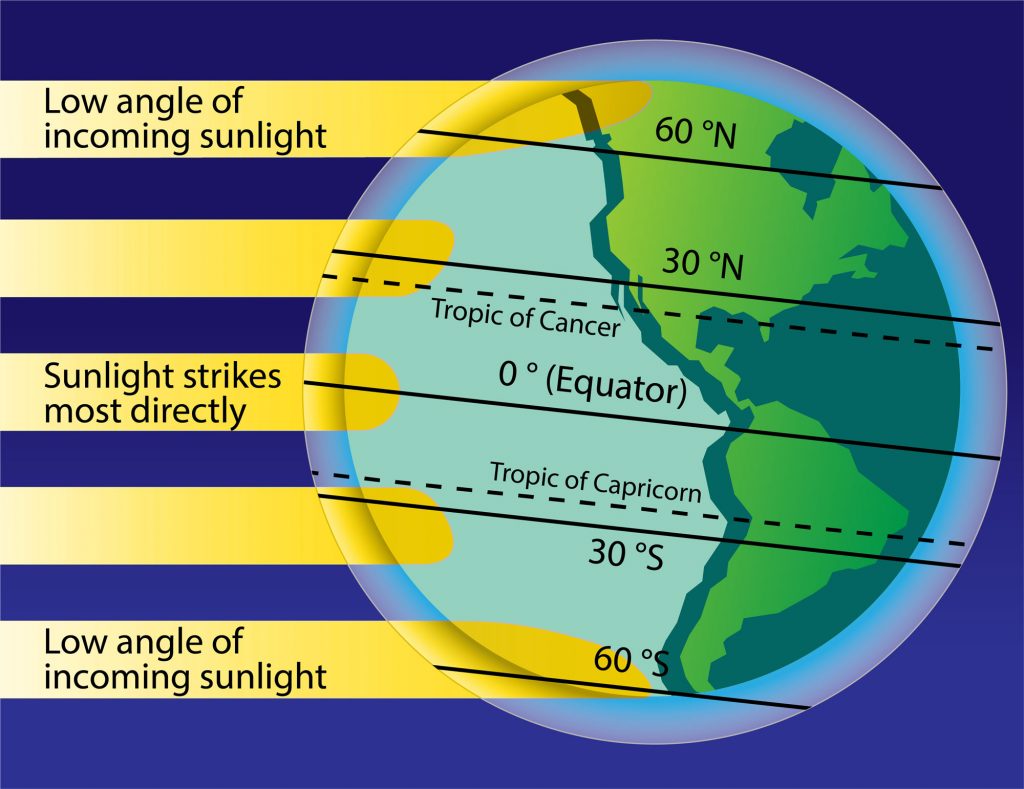
The Earth is unevenly heated because it is a sphere.
Because Earth is a sphere, not all part of the Earth receives the same amount of solar radiation. More solar radiation is received and absorbed near the equator than at the poles. Near the equator, the Sun’s rays strike the Earth most directly, while at the poles the rays strike at a steep angle. This means that less solar radiation is absorbed per square cm (or inch) of surface area at higher latitudes than at lower latitudes, and that the tropics are warmer than the poles. This temperature difference shapes global atmospheric and ocean circulation patterns. Additionally, Earth’s tilt affects how much sunlight is received and absorbed by different parts of the Earth at various times of the year, and is why we experience the seasons. The amount of solar radiation received and absorbed also influences process in the biosphere by directly affecting plants and other organisms that photosynthesize and are the primary food source in most ecosystems (see species interactions ).
If light is not absorbed by a surface, it is mostly reflected. Reflection occurs when incoming solar radiation bounces back from an object or surface that it strikes in the atmosphere, on land, or water, and is not transformed into heat. The proportion of incoming solar radiation that is reflected by the Earth is known as its albedo. Overall, Earth reflects about 29% of the incoming solar radiation, and therefore, we say the Earth’s average albedo is 0.29.
Snow and ice , airborne particles , and certain gases have high albedos and reflect different amounts of sunlight back into space. Low, thick clouds are reflective and can block sunlight from reaching the Earth’s surface, while high, thin clouds can contribute to the greenhouse effect.
The proportion of sunlight that’s reflected vs. absorbed, the re-radiation of heat, and the intensity of the greenhouse effect influence the amount of energy in the Earth system and global processes such as the water cycle and atmospheric and ocean circulation.
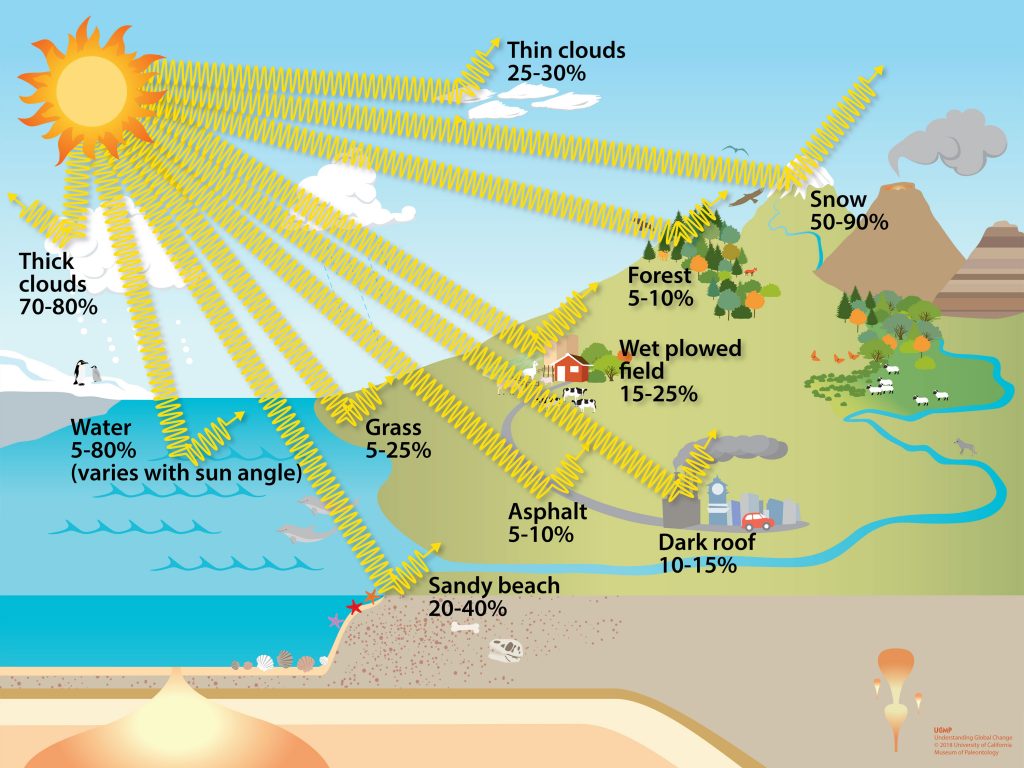
This diagram shows the percentage of sunlight that is reflected by different Earth surfaces or clouds.
This Earth system model is one way to represent the essential processes and interactions related to the absorption and reflection of sunlight. Hover over the icons for brief explanations; click on the icons to learn more about each topic. Download the Earth system models on this page.
This model shows some of the changes to Earth’s surface and atmosphere that can affect the amount of sunlight that is absorbed or reflected. These changes influence the amount of heat that is re-radiated, and can also greatly influence the biosphere by altering the amount of sunlight available for photosynthesis.
The Earth system model below includes some of the ways that human activities directly affect the amount of sunlight that is absorbed and reflected by Earth’s surface. The development and spread of urban areas, especially using asphalt and other dark colored materials, can dramatically increase the absorptivity of the surface. This creates urban heat islands, where cities experience higher temperatures than surrounding areas. Hover over or click on the icons to learn more about these human causes of change and how they influence the absorption and reflection of sunlight.
The Earth system model below includes additional ways that human activities directly affect the amount of sunlight that is absorbed and reflected by Earth’s atmosphere. Hover over or click on the icons to learn more about these human causes of change and how they influence the absorption and reflection of sunlight.
The Earth system model below shows how human pollutants and waste affect the ozone layer and the amount of ultraviolet sunlight that is absorbed by Earth’s upper atmosphere (the stratosphere). Hover over or click on the icons to learn more about these human causes of change and how they influence the absorption and reflection of sunlight.
Click the icons and bolded terms (e.g. re-radiation of heat, airborne particles, etc.) on this page to learn more about these process and phenomena. Alternatively, explore the Understanding Global Change Infographic and find new topics that are of interest and/or locally relevant to you.
To learn more about teaching the absorption and reflection of sunlight, visit the Teaching Resources page.
- Earth’s Energy Budget
- Measuring Earth’s Albedo via Satellite/ CERES
- A brief description of NASA’s “Clouds and the Earth’s Radiant Energy System” (CERES) satellite instruments
- Woods Hole Oceanographic Institution: How tiny plants help make clouds
- Earth’s Albedo and Global Warming
- NOAA Science on a Sphere, Aerosols: Black carbon and sulfate
- Ozone: What is it, and why do we care about it?
- Search Menu
Sign in through your institution
- Browse content in Arts and Humanities
- Browse content in Archaeology
- Anglo-Saxon and Medieval Archaeology
- Archaeological Methodology and Techniques
- Archaeology by Region
- Archaeology of Religion
- Archaeology of Trade and Exchange
- Biblical Archaeology
- Contemporary and Public Archaeology
- Environmental Archaeology
- Historical Archaeology
- History and Theory of Archaeology
- Industrial Archaeology
- Landscape Archaeology
- Mortuary Archaeology
- Prehistoric Archaeology
- Underwater Archaeology
- Zooarchaeology
- Browse content in Architecture
- Architectural Structure and Design
- History of Architecture
- Residential and Domestic Buildings
- Theory of Architecture
- Browse content in Art
- Art Subjects and Themes
- History of Art
- Industrial and Commercial Art
- Theory of Art
- Biographical Studies
- Byzantine Studies
- Browse content in Classical Studies
- Classical History
- Classical Philosophy
- Classical Mythology
- Classical Literature
- Classical Reception
- Classical Art and Architecture
- Classical Oratory and Rhetoric
- Greek and Roman Epigraphy
- Greek and Roman Law
- Greek and Roman Papyrology
- Greek and Roman Archaeology
- Late Antiquity
- Religion in the Ancient World
- Digital Humanities
- Browse content in History
- Colonialism and Imperialism
- Diplomatic History
- Environmental History
- Genealogy, Heraldry, Names, and Honours
- Genocide and Ethnic Cleansing
- Historical Geography
- History by Period
- History of Emotions
- History of Agriculture
- History of Education
- History of Gender and Sexuality
- Industrial History
- Intellectual History
- International History
- Labour History
- Legal and Constitutional History
- Local and Family History
- Maritime History
- Military History
- National Liberation and Post-Colonialism
- Oral History
- Political History
- Public History
- Regional and National History
- Revolutions and Rebellions
- Slavery and Abolition of Slavery
- Social and Cultural History
- Theory, Methods, and Historiography
- Urban History
- World History
- Browse content in Language Teaching and Learning
- Language Learning (Specific Skills)
- Language Teaching Theory and Methods
- Browse content in Linguistics
- Applied Linguistics
- Cognitive Linguistics
- Computational Linguistics
- Forensic Linguistics
- Grammar, Syntax and Morphology
- Historical and Diachronic Linguistics
- History of English
- Language Acquisition
- Language Evolution
- Language Reference
- Language Variation
- Language Families
- Lexicography
- Linguistic Anthropology
- Linguistic Theories
- Linguistic Typology
- Phonetics and Phonology
- Psycholinguistics
- Sociolinguistics
- Translation and Interpretation
- Writing Systems
- Browse content in Literature
- Bibliography
- Children's Literature Studies
- Literary Studies (Asian)
- Literary Studies (European)
- Literary Studies (Eco-criticism)
- Literary Studies (Romanticism)
- Literary Studies (American)
- Literary Studies (Modernism)
- Literary Studies - World
- Literary Studies (1500 to 1800)
- Literary Studies (19th Century)
- Literary Studies (20th Century onwards)
- Literary Studies (African American Literature)
- Literary Studies (British and Irish)
- Literary Studies (Early and Medieval)
- Literary Studies (Fiction, Novelists, and Prose Writers)
- Literary Studies (Gender Studies)
- Literary Studies (Graphic Novels)
- Literary Studies (History of the Book)
- Literary Studies (Plays and Playwrights)
- Literary Studies (Poetry and Poets)
- Literary Studies (Postcolonial Literature)
- Literary Studies (Queer Studies)
- Literary Studies (Science Fiction)
- Literary Studies (Travel Literature)
- Literary Studies (War Literature)
- Literary Studies (Women's Writing)
- Literary Theory and Cultural Studies
- Mythology and Folklore
- Shakespeare Studies and Criticism
- Browse content in Media Studies
- Browse content in Music
- Applied Music
- Dance and Music
- Ethics in Music
- Ethnomusicology
- Gender and Sexuality in Music
- Medicine and Music
- Music Cultures
- Music and Religion
- Music and Media
- Music and Culture
- Music Education and Pedagogy
- Music Theory and Analysis
- Musical Scores, Lyrics, and Libretti
- Musical Structures, Styles, and Techniques
- Musicology and Music History
- Performance Practice and Studies
- Race and Ethnicity in Music
- Sound Studies
- Browse content in Performing Arts
- Browse content in Philosophy
- Aesthetics and Philosophy of Art
- Epistemology
- Feminist Philosophy
- History of Western Philosophy
- Metaphysics
- Moral Philosophy
- Non-Western Philosophy
- Philosophy of Science
- Philosophy of Language
- Philosophy of Mind
- Philosophy of Perception
- Philosophy of Action
- Philosophy of Law
- Philosophy of Religion
- Philosophy of Mathematics and Logic
- Practical Ethics
- Social and Political Philosophy
- Browse content in Religion
- Biblical Studies
- Christianity
- East Asian Religions
- History of Religion
- Judaism and Jewish Studies
- Qumran Studies
- Religion and Education
- Religion and Health
- Religion and Politics
- Religion and Science
- Religion and Law
- Religion and Art, Literature, and Music
- Religious Studies
- Browse content in Society and Culture
- Cookery, Food, and Drink
- Cultural Studies
- Customs and Traditions
- Ethical Issues and Debates
- Hobbies, Games, Arts and Crafts
- Natural world, Country Life, and Pets
- Popular Beliefs and Controversial Knowledge
- Sports and Outdoor Recreation
- Technology and Society
- Travel and Holiday
- Visual Culture
- Browse content in Law
- Arbitration
- Browse content in Company and Commercial Law
- Commercial Law
- Company Law
- Browse content in Comparative Law
- Systems of Law
- Competition Law
- Browse content in Constitutional and Administrative Law
- Government Powers
- Judicial Review
- Local Government Law
- Military and Defence Law
- Parliamentary and Legislative Practice
- Construction Law
- Contract Law
- Browse content in Criminal Law
- Criminal Procedure
- Criminal Evidence Law
- Sentencing and Punishment
- Employment and Labour Law
- Environment and Energy Law
- Browse content in Financial Law
- Banking Law
- Insolvency Law
- History of Law
- Human Rights and Immigration
- Intellectual Property Law
- Browse content in International Law
- Private International Law and Conflict of Laws
- Public International Law
- IT and Communications Law
- Jurisprudence and Philosophy of Law
- Law and Politics
- Law and Society
- Browse content in Legal System and Practice
- Courts and Procedure
- Legal Skills and Practice
- Primary Sources of Law
- Regulation of Legal Profession
- Medical and Healthcare Law
- Browse content in Policing
- Criminal Investigation and Detection
- Police and Security Services
- Police Procedure and Law
- Police Regional Planning
- Browse content in Property Law
- Personal Property Law
- Study and Revision
- Terrorism and National Security Law
- Browse content in Trusts Law
- Wills and Probate or Succession
- Browse content in Medicine and Health
- Browse content in Allied Health Professions
- Arts Therapies
- Clinical Science
- Dietetics and Nutrition
- Occupational Therapy
- Operating Department Practice
- Physiotherapy
- Radiography
- Speech and Language Therapy
- Browse content in Anaesthetics
- General Anaesthesia
- Neuroanaesthesia
- Browse content in Clinical Medicine
- Acute Medicine
- Cardiovascular Medicine
- Clinical Genetics
- Clinical Pharmacology and Therapeutics
- Dermatology
- Endocrinology and Diabetes
- Gastroenterology
- Genito-urinary Medicine
- Geriatric Medicine
- Infectious Diseases
- Medical Toxicology
- Medical Oncology
- Pain Medicine
- Palliative Medicine
- Rehabilitation Medicine
- Respiratory Medicine and Pulmonology
- Rheumatology
- Sleep Medicine
- Sports and Exercise Medicine
- Clinical Neuroscience
- Community Medical Services
- Critical Care
- Emergency Medicine
- Forensic Medicine
- Haematology
- History of Medicine
- Browse content in Medical Dentistry
- Oral and Maxillofacial Surgery
- Paediatric Dentistry
- Restorative Dentistry and Orthodontics
- Surgical Dentistry
- Browse content in Medical Skills
- Clinical Skills
- Communication Skills
- Nursing Skills
- Surgical Skills
- Medical Ethics
- Medical Statistics and Methodology
- Browse content in Neurology
- Clinical Neurophysiology
- Neuropathology
- Nursing Studies
- Browse content in Obstetrics and Gynaecology
- Gynaecology
- Occupational Medicine
- Ophthalmology
- Otolaryngology (ENT)
- Browse content in Paediatrics
- Neonatology
- Browse content in Pathology
- Chemical Pathology
- Clinical Cytogenetics and Molecular Genetics
- Histopathology
- Medical Microbiology and Virology
- Patient Education and Information
- Browse content in Pharmacology
- Psychopharmacology
- Browse content in Popular Health
- Caring for Others
- Complementary and Alternative Medicine
- Self-help and Personal Development
- Browse content in Preclinical Medicine
- Cell Biology
- Molecular Biology and Genetics
- Reproduction, Growth and Development
- Primary Care
- Professional Development in Medicine
- Browse content in Psychiatry
- Addiction Medicine
- Child and Adolescent Psychiatry
- Forensic Psychiatry
- Learning Disabilities
- Old Age Psychiatry
- Psychotherapy
- Browse content in Public Health and Epidemiology
- Epidemiology
- Public Health
- Browse content in Radiology
- Clinical Radiology
- Interventional Radiology
- Nuclear Medicine
- Radiation Oncology
- Reproductive Medicine
- Browse content in Surgery
- Cardiothoracic Surgery
- Gastro-intestinal and Colorectal Surgery
- General Surgery
- Neurosurgery
- Paediatric Surgery
- Peri-operative Care
- Plastic and Reconstructive Surgery
- Surgical Oncology
- Transplant Surgery
- Trauma and Orthopaedic Surgery
- Vascular Surgery
- Browse content in Science and Mathematics
- Browse content in Biological Sciences
- Aquatic Biology
- Biochemistry
- Bioinformatics and Computational Biology
- Developmental Biology
- Ecology and Conservation
- Evolutionary Biology
- Genetics and Genomics
- Microbiology
- Molecular and Cell Biology
- Natural History
- Plant Sciences and Forestry
- Research Methods in Life Sciences
- Structural Biology
- Systems Biology
- Zoology and Animal Sciences
- Browse content in Chemistry
- Analytical Chemistry
- Computational Chemistry
- Crystallography
- Environmental Chemistry
- Industrial Chemistry
- Inorganic Chemistry
- Materials Chemistry
- Medicinal Chemistry
- Mineralogy and Gems
- Organic Chemistry
- Physical Chemistry
- Polymer Chemistry
- Study and Communication Skills in Chemistry
- Theoretical Chemistry
- Browse content in Computer Science
- Artificial Intelligence
- Computer Architecture and Logic Design
- Game Studies
- Human-Computer Interaction
- Mathematical Theory of Computation
- Programming Languages
- Software Engineering
- Systems Analysis and Design
- Virtual Reality
- Browse content in Computing
- Business Applications
- Computer Security
- Computer Games
- Computer Networking and Communications
- Digital Lifestyle
- Graphical and Digital Media Applications
- Operating Systems
- Browse content in Earth Sciences and Geography
- Atmospheric Sciences
- Environmental Geography
- Geology and the Lithosphere
- Maps and Map-making
- Meteorology and Climatology
- Oceanography and Hydrology
- Palaeontology
- Physical Geography and Topography
- Regional Geography
- Soil Science
- Urban Geography
- Browse content in Engineering and Technology
- Agriculture and Farming
- Biological Engineering
- Civil Engineering, Surveying, and Building
- Electronics and Communications Engineering
- Energy Technology
- Engineering (General)
- Environmental Science, Engineering, and Technology
- History of Engineering and Technology
- Mechanical Engineering and Materials
- Technology of Industrial Chemistry
- Transport Technology and Trades
- Browse content in Environmental Science
- Applied Ecology (Environmental Science)
- Conservation of the Environment (Environmental Science)
- Environmental Sustainability
- Environmentalist Thought and Ideology (Environmental Science)
- Management of Land and Natural Resources (Environmental Science)
- Natural Disasters (Environmental Science)
- Nuclear Issues (Environmental Science)
- Pollution and Threats to the Environment (Environmental Science)
- Social Impact of Environmental Issues (Environmental Science)
- History of Science and Technology
- Browse content in Materials Science
- Ceramics and Glasses
- Composite Materials
- Metals, Alloying, and Corrosion
- Nanotechnology
- Browse content in Mathematics
- Applied Mathematics
- Biomathematics and Statistics
- History of Mathematics
- Mathematical Education
- Mathematical Finance
- Mathematical Analysis
- Numerical and Computational Mathematics
- Probability and Statistics
- Pure Mathematics
- Browse content in Neuroscience
- Cognition and Behavioural Neuroscience
- Development of the Nervous System
- Disorders of the Nervous System
- History of Neuroscience
- Invertebrate Neurobiology
- Molecular and Cellular Systems
- Neuroendocrinology and Autonomic Nervous System
- Neuroscientific Techniques
- Sensory and Motor Systems
- Browse content in Physics
- Astronomy and Astrophysics
- Atomic, Molecular, and Optical Physics
- Biological and Medical Physics
- Classical Mechanics
- Computational Physics
- Condensed Matter Physics
- Electromagnetism, Optics, and Acoustics
- History of Physics
- Mathematical and Statistical Physics
- Measurement Science
- Nuclear Physics
- Particles and Fields
- Plasma Physics
- Quantum Physics
- Relativity and Gravitation
- Semiconductor and Mesoscopic Physics
- Browse content in Psychology
- Affective Sciences
- Clinical Psychology
- Cognitive Psychology
- Cognitive Neuroscience
- Criminal and Forensic Psychology
- Developmental Psychology
- Educational Psychology
- Evolutionary Psychology
- Health Psychology
- History and Systems in Psychology
- Music Psychology
- Neuropsychology
- Organizational Psychology
- Psychological Assessment and Testing
- Psychology of Human-Technology Interaction
- Psychology Professional Development and Training
- Research Methods in Psychology
- Social Psychology
- Browse content in Social Sciences
- Browse content in Anthropology
- Anthropology of Religion
- Human Evolution
- Medical Anthropology
- Physical Anthropology
- Regional Anthropology
- Social and Cultural Anthropology
- Theory and Practice of Anthropology
- Browse content in Business and Management
- Business Strategy
- Business Ethics
- Business History
- Business and Government
- Business and Technology
- Business and the Environment
- Comparative Management
- Corporate Governance
- Corporate Social Responsibility
- Entrepreneurship
- Health Management
- Human Resource Management
- Industrial and Employment Relations
- Industry Studies
- Information and Communication Technologies
- International Business
- Knowledge Management
- Management and Management Techniques
- Operations Management
- Organizational Theory and Behaviour
- Pensions and Pension Management
- Public and Nonprofit Management
- Strategic Management
- Supply Chain Management
- Browse content in Criminology and Criminal Justice
- Criminal Justice
- Criminology
- Forms of Crime
- International and Comparative Criminology
- Youth Violence and Juvenile Justice
- Development Studies
- Browse content in Economics
- Agricultural, Environmental, and Natural Resource Economics
- Asian Economics
- Behavioural Finance
- Behavioural Economics and Neuroeconomics
- Econometrics and Mathematical Economics
- Economic Systems
- Economic History
- Economic Methodology
- Economic Development and Growth
- Financial Markets
- Financial Institutions and Services
- General Economics and Teaching
- Health, Education, and Welfare
- History of Economic Thought
- International Economics
- Labour and Demographic Economics
- Law and Economics
- Macroeconomics and Monetary Economics
- Microeconomics
- Public Economics
- Urban, Rural, and Regional Economics
- Welfare Economics
- Browse content in Education
- Adult Education and Continuous Learning
- Care and Counselling of Students
- Early Childhood and Elementary Education
- Educational Equipment and Technology
- Educational Strategies and Policy
- Higher and Further Education
- Organization and Management of Education
- Philosophy and Theory of Education
- Schools Studies
- Secondary Education
- Teaching of a Specific Subject
- Teaching of Specific Groups and Special Educational Needs
- Teaching Skills and Techniques
- Browse content in Environment
- Applied Ecology (Social Science)
- Climate Change
- Conservation of the Environment (Social Science)
- Environmentalist Thought and Ideology (Social Science)
- Natural Disasters (Environment)
- Social Impact of Environmental Issues (Social Science)
- Browse content in Human Geography
- Cultural Geography
- Economic Geography
- Political Geography
- Browse content in Interdisciplinary Studies
- Communication Studies
- Museums, Libraries, and Information Sciences
- Browse content in Politics
- African Politics
- Asian Politics
- Chinese Politics
- Comparative Politics
- Conflict Politics
- Elections and Electoral Studies
- Environmental Politics
- European Union
- Foreign Policy
- Gender and Politics
- Human Rights and Politics
- Indian Politics
- International Relations
- International Organization (Politics)
- International Political Economy
- Irish Politics
- Latin American Politics
- Middle Eastern Politics
- Political Methodology
- Political Communication
- Political Philosophy
- Political Sociology
- Political Behaviour
- Political Economy
- Political Institutions
- Political Theory
- Politics and Law
- Politics of Development
- Public Administration
- Public Policy
- Quantitative Political Methodology
- Regional Political Studies
- Russian Politics
- Security Studies
- State and Local Government
- UK Politics
- US Politics
- Browse content in Regional and Area Studies
- African Studies
- Asian Studies
- East Asian Studies
- Japanese Studies
- Latin American Studies
- Middle Eastern Studies
- Native American Studies
- Scottish Studies
- Browse content in Research and Information
- Research Methods
- Browse content in Social Work
- Addictions and Substance Misuse
- Adoption and Fostering
- Care of the Elderly
- Child and Adolescent Social Work
- Couple and Family Social Work
- Direct Practice and Clinical Social Work
- Emergency Services
- Human Behaviour and the Social Environment
- International and Global Issues in Social Work
- Mental and Behavioural Health
- Social Justice and Human Rights
- Social Policy and Advocacy
- Social Work and Crime and Justice
- Social Work Macro Practice
- Social Work Practice Settings
- Social Work Research and Evidence-based Practice
- Welfare and Benefit Systems
- Browse content in Sociology
- Childhood Studies
- Community Development
- Comparative and Historical Sociology
- Economic Sociology
- Gender and Sexuality
- Gerontology and Ageing
- Health, Illness, and Medicine
- Marriage and the Family
- Migration Studies
- Occupations, Professions, and Work
- Organizations
- Population and Demography
- Race and Ethnicity
- Social Theory
- Social Movements and Social Change
- Social Research and Statistics
- Social Stratification, Inequality, and Mobility
- Sociology of Religion
- Sociology of Education
- Sport and Leisure
- Urban and Rural Studies
- Browse content in Warfare and Defence
- Defence Strategy, Planning, and Research
- Land Forces and Warfare
- Military Administration
- Military Life and Institutions
- Naval Forces and Warfare
- Other Warfare and Defence Issues
- Peace Studies and Conflict Resolution
- Weapons and Equipment

A newer edition of this book is available.
- < Previous chapter
10 (page 173) p. 173 Conclusion
- Published: November 2008
- Cite Icon Cite
- Permissions Icon Permissions
The ‘Conclusion’ confirms that global warming is the major challenge for our global society. There is very little doubt that global warming will change our climate in the next century. So what are the solutions to global warming? First, there must be an international political solution. Second, funding for developing cheap and clean energy production must be increased, as all economic development is based on increasing energy usage. We must not pin all our hopes on global politics and clean energy technology, so we must prepare for the worst and adapt. If implemented now, a lot of the costs and damage that could be caused by changing climate can be mitigated.
Signed in as
Institutional accounts.
- Google Scholar Indexing
- GoogleCrawler [DO NOT DELETE]
Personal account
- Sign in with email/username & password
- Get email alerts
- Save searches
- Purchase content
- Activate your purchase/trial code
- Add your ORCID iD
Institutional access
Sign in with a library card.
- Sign in with username/password
- Recommend to your librarian
- Institutional account management
- Get help with access
Access to content on Oxford Academic is often provided through institutional subscriptions and purchases. If you are a member of an institution with an active account, you may be able to access content in one of the following ways:
IP based access
Typically, access is provided across an institutional network to a range of IP addresses. This authentication occurs automatically, and it is not possible to sign out of an IP authenticated account.
Choose this option to get remote access when outside your institution. Shibboleth/Open Athens technology is used to provide single sign-on between your institution’s website and Oxford Academic.
- Click Sign in through your institution.
- Select your institution from the list provided, which will take you to your institution's website to sign in.
- When on the institution site, please use the credentials provided by your institution. Do not use an Oxford Academic personal account.
- Following successful sign in, you will be returned to Oxford Academic.
If your institution is not listed or you cannot sign in to your institution’s website, please contact your librarian or administrator.
Enter your library card number to sign in. If you cannot sign in, please contact your librarian.
Society Members
Society member access to a journal is achieved in one of the following ways:
Sign in through society site
Many societies offer single sign-on between the society website and Oxford Academic. If you see ‘Sign in through society site’ in the sign in pane within a journal:
- Click Sign in through society site.
- When on the society site, please use the credentials provided by that society. Do not use an Oxford Academic personal account.
If you do not have a society account or have forgotten your username or password, please contact your society.
Sign in using a personal account
Some societies use Oxford Academic personal accounts to provide access to their members. See below.
A personal account can be used to get email alerts, save searches, purchase content, and activate subscriptions.
Some societies use Oxford Academic personal accounts to provide access to their members.
Viewing your signed in accounts
Click the account icon in the top right to:
- View your signed in personal account and access account management features.
- View the institutional accounts that are providing access.
Signed in but can't access content
Oxford Academic is home to a wide variety of products. The institutional subscription may not cover the content that you are trying to access. If you believe you should have access to that content, please contact your librarian.
For librarians and administrators, your personal account also provides access to institutional account management. Here you will find options to view and activate subscriptions, manage institutional settings and access options, access usage statistics, and more.
Our books are available by subscription or purchase to libraries and institutions.
- About Oxford Academic
- Publish journals with us
- University press partners
- What we publish
- New features
- Open access
- Rights and permissions
- Accessibility
- Advertising
- Media enquiries
- Oxford University Press
- Oxford Languages
- University of Oxford
Oxford University Press is a department of the University of Oxford. It furthers the University's objective of excellence in research, scholarship, and education by publishing worldwide
- Copyright © 2024 Oxford University Press
- Cookie settings
- Cookie policy
- Privacy policy
- Legal notice
This Feature Is Available To Subscribers Only
Sign In or Create an Account
This PDF is available to Subscribers Only
For full access to this pdf, sign in to an existing account, or purchase an annual subscription.
Study: Reflecting sunlight to cool the planet will cause other global changes
How can the world combat the continued rise in global temperatures? How about shading the Earth from a portion of the sun’s heat by injecting the stratosphere with reflective aerosols? After all, volcanoes do essentially the same thing, albeit in short, dramatic bursts: When a Vesuvius erupts, it blasts fine ash into the atmosphere, where the particles can linger as a kind of cloud cover, reflecting solar radiation back into space and temporarily cooling the planet.
Some researchers are exploring proposals to engineer similar effects, for example by launching reflective aerosols into the stratosphere — via planes, balloons, and even blimps — in order to block the sun’s heat and counteract global warming. But such solar geoengineering schemes, as they are known, could have other long-lasting effects on the climate.
Now scientists at MIT have found that solar geoengineering would significantly change extratropical storm tracks — the zones in the middle and high latitudes where storms form year-round and are steered by the jet stream across the oceans and land. Extratropical storm tracks give rise to extratropical cyclones, and not their tropical cousins, hurricanes. The strength of extratropical storm tracks determines the severity and frequency of storms such as nor’easters in the United States.
The team considered an idealized scenario in which solar radiation was reflected enough to offset the warming that would occur if carbon dioxide were to quadruple in concentration. In a number of global climate models under this scenario, the strength of storm tracks in both the northern and southern hemispheres weakened significantly in response.
Weakened storm tracks would mean less powerful winter storms, but the team cautions that weaker storm tracks also lead to stagnant conditions, particularly in summer, and less wind to clear away air pollution. Changes in winds could also affect the circulation of ocean waters and, in turn, the stability of ice sheets.
“About half the world’s population lives in the extratropical regions where storm tracks dominate weather,” says Charles Gertler, a graduate student in MIT’s Department of Earth, Atmospheric and Planetary Sciences (EAPS). “Our results show that solar geoengineering will not simply reverse climate change. Instead, it has the potential itself to induce novel changes in climate.”
Gertler and his colleagues have published their results this week in the journal Geophysical Research Letters . Co-authors include EAPS Professor Paul O’Gorman, along with Ben Kravitz of Indiana State University, John Moore of Beijing Normal University, Steven Phipps of the University of Tasmania, and Shingo Watanabe of the Japan Agency for Marine-Earth Science and Technology
A not-so-sunny picture
Scientists have previously modeled what Earth’s climate might look like if solar geoengineering scenarios were to play out on a global scale, with mixed results. On the one hand, spraying aerosols into the stratosphere would reduce incoming solar heat and, to a degree, counteract the warming caused by carbon dioxide emissions. On the other hand, such cooling of the planet would not prevent other greenhouse gas-induced effects such as regional reductions in rainfall and ocean acidification.
There have also been signs that intentionally reducing solar radiation would shrink the temperature difference between the Earth’s equator and poles or, in climate parlance, weaken the planet’s meridional temperature gradient, cooling the equator while the poles continue to warm. This last consequence was especially intriguing to Gertler and O’Gorman.
“Storm tracks feed off of meridional temperature gradients, and storm tracks are interesting because they help us to understand weather extremes,” Gertler says. “So we were interested in how geoengineering affects storm tracks.”
The team looked at how extratropical storm tracks might change under a scenario of solar geoengineering known to climate scientists as experiment G1 of the Geoengineering Model Intercomparison Project (GeoMIP), a project that provides various geoengineering scenarios for scientists to run on climate models to assess their various climate effects.
The G1 experiment assumes an idealized scenario in which a solar geoengineering scheme blocks enough solar radiation to counterbalance the warming that would occur if carbon dioxide concentrations were to quadruple.
The researchers used results from various climate models run forward in time under the conditions of the G1 experiment. They also used results from a more sophisticated geoengineering scenario with doubling of carbon dioxide concentrations and aerosols injected into the stratosphere at more than one latitude. In each model they recorded the day-to-day change in air pressure at sea level pressure at various locations along the storm tracks. These changes reflect the passage of storms and measure a storm track’s energy.
“If we look at the variance in sea level pressure, we have a sense of how often and how strongly cyclones pass over each area,” Gertler explains. “We then average the variance across the whole extratropical region, to get an average value of storm track strength for the northern and southern hemispheres.”
An imperfect counterbalance
Their results, across climate models, showed that solar geoengineering would weaken storm tracks in both Northern and Southern hemispheres. Depending on the scenario they considered, the storm track in the Northern Hemisphere would be 5 to 17 percent weaker than it is today.
“A weakened storm track, in both hemispheres, would mean weaker winter storms but also lead to more stagnant weather, which could affect heat waves,” Gertler says. “Across all seasons, this could affect ventilation of air pollution. It also may contribute to a weakening of the hydrological cycle, with regional reductions in rainfall. These are not good changes, compared to a baseline climate that we are used to.”
The researchers were curious to see how the same storm tracks would respond to just global warming alone, without the addition of social geoengineering, so they ran the climate models again under several warming-only scenarios. Surprisingly, they found that, in the northern hemisphere, global warming would also weaken storm tracks, by the same magnitude as with the addition of solar geoengineering. This suggests solar geoengineering, and efforts to cool the Earth by reducing incoming heat, would not do much to alter global warming’s effects, at least on storm tracks — a puzzling outcome that the researchers are unsure how to explain.
In the Southern Hemisphere, there is a slightly different story. They found that global warming alone would strengthen storm tracks there, whereas the addition of solar geoengineering would prevent this strengthening, and even further, would weaken the storm tracks there.
“In the Southern Hemisphere, winds drive ocean circulation, which in turn could affect uptake of carbon dioxide, and the stability of the Antarctic ice sheet,” O’Gorman adds. “So how storm tracks change over the Southern Hemisphere is quite important.”
The team also observed that the weakening of storm tracks was strongly correlated with changes in temperature and humidity. Specifically, the climate models showed that in response to reduced incoming solar radiation, the equator cooled significantly as the poles continued to warm. This reduced temperature gradient appears to be sufficient to explain the weakening storm tracks — a result that the group is the first to demonstrate.
“This work highlights that solar geoengineering is not reversing climate change, but is substituting one unprecedented climate state for another,” Gertler says. “Reflecting sunlight isn’t a perfect counterbalance to the greenhouse effect.”
Adds O’Gorman: “There are multiple reasons to avoid doing this, and instead to favor reducing emissions of CO 2 and other greenhouse gases.”
This research was funded, in part, by the National Science Foundation, NASA, and the Industry and Foundation sponsors of the MIT Joint Program on the Science and Policy of Global Change.

Related Posts
The flawed logic of rushing out extreme climate interventions.
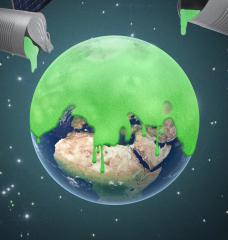
Turning Evolutionary Dials: Directed Evolution Techniques for Climate Chang...

The US government is developing a solar geoengineering research plan

Given what we know, how do we live now?

MIT Climate News in Your Inbox
Advertisement
Supported by
A Test of Cloud-Brightening Machines Poses No Health Risk, Officials Say
After halting a test of controversial technology to fight global warming, the city of Alameda, Calif., said it had found no “measurable health risk” from the giant salty-mist-spraying fans.
- Share full article

By Christopher Flavelle
A technology that could one day cool the planet cleared a key hurdle on Thursday.
At the beginning of April, scientists from the University of Washington began testing a device that sprays tiny sea-salt particles into the air. The initial tests, held on the deck of a decommissioned aircraft carrier in Alameda, Calif., were simply to see if the machine propelled a mist of suitable size. But, in the future, versions of that device could eventually be used to spray particles into clouds, causing them to reflect more sunlight back into space and to temporarily ease global warming.
Two weeks later, Alameda officials ordered the researchers to stop their experiment, citing possible health and environmental risks. The city said it would commission its own assessment to determine whether the experiment posed any threat.
On Thursday evening, Alameda released its findings : The experiment does not generate “a measurable health risk to the surrounding community” or pose a risk to wildlife, the city said.
“The chemical components of the saltwater solution (which is similar to seawater) being sprayed are naturally occurring in the environment,” the report said. It also noted that seawater “is one of the largest sources of natural aerosols in the atmosphere.”
Alameda city councilors plan to meet on June 4 to consider the report and to decide whether to allow the experiment to resume. Researchers had hoped to test the device in different weather conditions over several months or more.
The report, presented by Alameda’s city manager, recommends that the City Council “consider granting” that permission, with additional safeguards in place. The recommended safeguards include setting up air quality monitors at the test site and limiting the hours during which the device can be used.
Officials also recommended that the City Council require the researchers to show in writing that the experiment meets “all local, state and federal regulations,” including written confirmation from the Bay Area Air Quality Management District and the Regional Water Quality Control Board.
A spokeswoman for Alameda, Sarah Henry, said that the officials who had written the report were not authorized to comment on it.
The director of the Marine Cloud Brightening Program at the University of Washington, Sarah J. Doherty, welcomed the report.
“Alameda has a high standard of care for its people and the local environment, and we appreciate the findings of their experts,” Dr. Doherty said. “This supports our own evaluation that this is a safe, publicly accessible way to further research on aerosols in the atmosphere.”
Brightening clouds is one of several ideas to push solar energy back into space, a concept sometimes called solar radiation modification, solar geoengineering or climate intervention.
The idea is built on a scientific concept called the Twomey effect: Large numbers of small droplets reflect more sunlight than small numbers of large droplets do. So spraying vast quantities of minuscule aerosols into the sky, forming many small droplets, could change the reflective properties of clouds.
Compared with other options, such as injecting aerosols into the stratosphere, marine cloud brightening would be localized and use relatively benign sea-salt aerosols in place of other chemicals.
Researchers say that there are potential side effects that still need to be studied, including changing ocean circulation patterns and temperatures that could hurt fisheries.
Environmentalists warn that the technology could thwart the deeper changes required to address climate change. If people believe that global warming can be addressed by artificially cooling the planet, some say, the momentum could slow toward renewable energy, electric vehicles and other changes required to reduce the emissions of planet-warming gases.
The researchers working on marine cloud brightening agree that the technology should not be viewed as a substitute for moving away from fossil fuels. Instead, they say that the research is important in case that transition continues to move slowly and short-term efforts to cool the planet become necessary. In other words, the technology might buy some extra time.
The strong emotions that typically accompany discussion of solar-geoengineering research could be seen in the debate over the experiment in Alameda. When the city said on Facebook that it was halting the experiment, commenters sparred over the decision.
“Leave our skies alone. The natural sunlight is our birthright,” one person wrote. Another commenter said: “They could do that in Washington. No need to do that here.” (The researchers say that the weather conditions in San Francisco Bay make it an ideal spot for the experiment.)
But the announcement also drew comments in support of the experiment. “I’m hopeful that this could be a tool to fight global warming,” one commenter said. “Some extra clouds would be nice,” another wrote.
Christopher Flavelle is a Times reporter who writes about how the United States is trying to adapt to the effects of climate change. More about Christopher Flavelle
Our Coverage of Climate and the Environment
News and Analysis
Heat and drought are taking a toll on the tiny soil creatures that help to lock away planet-warming carbon, according to a new analysis.
A group of health experts, economists and U.S. government lawyers are working to address a growing crisis: people dying on the job from extreme heat. They face big hurdles .
After halting a test of controversial technology to fight global warming , the city of Alameda, Calif., said it had found no “measurable health risk” from the giant salty-mist-spraying fans.
Adopting Orphaned Oil Wells: Students, nonprofit groups and others are fund-raising to cap highly polluting oil and gas wells abandoned by industry.
Struggling N.Y.C. Neighborhoods: New data projects are linking social issues with global warming. Here’s what that means for five communities in New York .
Biden Environmental Rules: The Biden administration has rushed to finalize 10 major environmental regulations to meet its self-imposed spring deadline.
F.A.Q.: Have questions about climate change? We’ve got answers .
Column: Samuel Alito’s ethical lapse isn’t the Supreme Court’s first. This is why it’s different

- Show more sharing options
- Copy Link URL Copied!
Another day, another ethics crisis at the Supreme Court.
When I first read about the upside-down American flag that flew at the Virginia home of Supreme Court Justice Samuel A. Alito Jr. in early 2021, I thought, “Boy, that’s dumb.”
When I later read about the “Appeal to Heaven” pine tree flag that flew at Alito’s beach home in New Jersey, I thought, “Wow, how many election denier flags is too many for a Supreme Court justice to own and display?”
Shouldn’t the answer be obvious?

Abcarian: Why are Republicans making it harder for some people to vote? It’s not just partisanship
A toxic brew of politics, racism and conservative Supreme Court rulings fuels the effort to prevent people of color and college students from casting ballots.
May 26, 2024
A Supreme Court justice should never behave in a manner that can be interpreted as politically partisan. Alito has claimed that the upside-down flag, a distress signal adopted by those denying Donald Trump’s 2020 election loss, was raised by his wife during a political dispute with neighbors. Tawdry as that sounds, it doesn’t matter. It‘s his house, too.
“A Supreme Court justice appears to have embraced election denialism,” Alicia Bannon of New York University’s Brennan Center for Justice told Reuters. “That’s a five-alarm fire.”
A sitting federal judge even weighed in: “Flying those flags was tantamount to sticking a ‘Stop the steal’ bumper sticker on your car,” Massachusetts-based senior U.S. District Judge Michael Ponsor wrote in a New York Times essay chastising Alito. “You just don’t do it.”
You just don’t do it.

Calmes: Will voters get the message that our judicial system is on the 2024 ballot too?
If you oppose right-wing activism among federal judges and justices, vote strategically in November.
May 23, 2024
The U.S. Supreme Court didn’t even have an official code of ethics until late last year , unlike the rest of the federal judiciary. Imagine: lifetime tenure and no codified ethics rules.
The idea that justices can be expected to monitor themselves for conflicts of interest and ethical lapses is absurd. No one can fairly judge themselves.
And now all the court has is a toothless set of guidelines with no enforcement mechanism.
For those whose reflexive what-aboutism kicks in whenever MAGA world comes under fire, it’s important to acknowledge that it was also wrong for Justice Ruth Bader Ginsburg to criticize then-presidential candidate Trump in 2016.
“I can’t imagine what this place would be — I can’t imagine what the country would be — with Donald Trump as our president,” RBG told the New York Times during an interview in her chambers four months before the election. “For the country, it could be four years. For the court, it could be — I don’t even want to contemplate that.”
(And it was improper for Justice Sonia Sotomayor to routinely ask her staff to prod libraries, universities and schools to buy her books ahead of speaking engagements. She also should have recused herself from a case involving her publisher. )
But when Ginsburg publicly let loose on Trump, hardly anyone thought the reality show billionaire was going to beat Hillary Clinton. Even Trump didn’t think he would win. Still, it was an inappropriate, incautious statement from a Supreme Court justice who should have known better.
And, days later, she confessed as much : “On reflection, my recent remarks in response to press inquiries were ill-advised, and I regret making them,” she said in a written statement released by the court. “Judges should avoid commenting on a candidate for public office. In the future I will be more circumspect.”
Ginsburg’s self-flagellation was not good enough for the Wall Street Journal’s conservative editorial board, which demanded that she resign or at the very least recuse herself from cases involving the presidential race and related matters. (She did not.)
But the Journal has made no such demand of Alito. Instead, right-wing media are awash with pieces about how the “left” is smearing the poor man.
This is the same defense trotted out by supporters of Justice Clarence Thomas, whose wealthy patrons have lavished him and his wife, Ginni, with a bonanza of hundreds of thousands of dollars in trips, private school tuition for a relative, an expensive RV and who knows what other blandishments. The Journal called ProPublica’s bombshell investigation of Thomas a “phony ethics assault.”
Unlike Ginsburg, Alito has not apologized for flying the flags nor, come to think of it, for failing to disclose that he accepted a 2008 trip to a luxury fishing lodge in Alaska from Republican donors, one of whom had an interest in cases before the court.
Instead, like his much-criticized colleague Thomas, he has responded with petulance.
Senate Judiciary Committee Chair Richard Durbin of Illinois and member Sheldon Whitehouse of Rhode Island last week asked Chief Justice John G. Roberts Jr. to direct Alito to recuse himself from any cases related to the 2020 presidential election and the Jan. 6, 2021, attack on the Capitol, which of course include the question of whether former President Trump has immunity from prosecution.
“The Court’s Code of Conduct has failed to redress or prevent any of these ethics violations, largely because it contains no enforcement mechanism,” they wrote.
Last year, the committee advanced a bill, the Supreme Court Ethics, Recusal and Transparency Act , that has yet to be taken up by the whole Senate and may never come to a vote given that body’s antiquated rules . The bill would require the justices to adopt a strict code of ethics and create a process for investigating and addressing alleged violations.
The court, whose credibility is near an all-time low , should have taken this step without prodding.
I had a good chuckle when I read in the Journal that “the people undermining confidence in the Supreme Court are those acting as if Justice Alito is sending secret signals from the flagpole at his beach house.”
You’ve got to be kidding, guys. There’s nothing secret about it.
@robinkabcarian
More to Read

Alito refuses to recuse himself from cases on Trump and Jan. 6 over flag controversy
May 29, 2024

Democratic senators urging chief justice to act on Alito recusal after flag controversy
May 25, 2024

The ‘Appeal to Heaven’ flag involved in Alito controversy evolved from Revolutionary War symbol to banner of the far right
May 24, 2024
A cure for the common opinion
Get thought-provoking perspectives with our weekly newsletter.
You may occasionally receive promotional content from the Los Angeles Times.

Robin Abcarian is an opinion columnist at the Los Angeles Times. She writes about news, politics and culture. Her columns appear on Wednesday and Sunday. Twitter: @AbcarianLAT
More From the Los Angeles Times

Robert F. Kennedy Jr. files complaint over rules for CNN’s presidential debate next month

Column: Trump wins! (One way or another.) Here’s why

Polls say a conviction could cost Trump a fifth of his support. Should we believe them?

World & Nation
Jurors in Trump hush money trial end 1st day of deliberations after asking to rehear testimony

IMAGES
VIDEO
COMMENTS
In response to last week's release of the UN's IPCC report on the climate, which warned that "unprecedented" changes were needed to slow or stop global warming beyond 1.5C pre-industrial period, it's easy judging by the headlines and subsequent global response to perhaps give up or sink into despair. "Terrifying." "Time to Wake ...
Essay on Global Warming Paragraph in 100 - 150 words. Global Warming is caused by the increase of carbon dioxide levels in the earth's atmosphere and is a result of human activities that have been causing harm to our environment for the past few centuries now. Global Warming is something that can't be ignored and steps have to be taken to ...
Some researchers are exploring proposals to engineer similar effects, for example by launching reflective aerosols into the stratosphere — via planes, balloons, and even blimps — in order to block the sun's heat and counteract global warming. But such solar geoengineering schemes, as they are known, could have other long-lasting effects ...
Bahçeşehir College is committed to increasing students' awareness of the changing world we live in. This climate change essay competition saw many students submitting well thought out pieces of writing. These essays were marked on their format, creativity, organisation, clarity, unity/development of thought, and grammar/mechanics.
I close my reflection examining how I feel about the probability the world will fail to avert dangerous climate change. I acknowledge that as Scotland is only responsible for a 700th of global emissions (Carrell, 2009) if it manages to meet its reduction targets 1 The original emissions reduction target proposed was 34% for 2020 (Carrell, 2009).
Billions of tons of carbon are released into the atmosphere every year by human action. An international panel of experts now agrees it is very likely that this is causing the Earth to warm, with unknown but potentially catastrophic consequences. But what does that mean to me? Consider in this reflection paper how you affect global climate change.
The climate crisis is causing shifts in the availability of resources and precipitating migration, which in turn impact human rights, national politics, and may increase conflict within and between countries. On a more local level, the climate crisis raises issues of justice. While every person is touched in some way by extreme weather events ...
Durban, South Africa. Looking back, this conference is probably the most important climate change gathering of our time with the whole world represented at COP17. At the very least, I would describe it as an explosion of thoughts — with the main concerns across the board being food security, water shortage, loss of biodiversity, population ...
carbon intensity of 11 per cent) to limit global warming to 2 o. Even if recent trends of global population (at 0.7 per cent per annum) and income growth (at 1.4 per cent per year) were just extrapolated to 2050, carbon intensity would have to be reduced to 36gCO 2 /$ - a 21-fold improvement on the current global average (see figure 1).5 Figure 1
Intern Reflection Essay: Climate Change Inequality. Posted on February 11, 2014 by Katie Main. Last summer I studied abroad in Iceland. A country at the forefront of renewable energy, Iceland has the potential to be a global leader in sustainability. Its energy is almost entirely powered from geothermal and hydroelectric and thus it is capable ...
Global warming is the long-term warming of the planet's overall temperature. Though this warming trend has been going on for a long time, its pace has significantly increased in the last hundred years due to the burning of fossil fuels.As the human population has increased, so has the volume of . fossil fuels burned.. Fossil fuels include coal, oil, and natural gas, and burning them causes ...
And even 2˚ is a significant amount of warming for the planet, and will have consequences in terms of sea level rise, ecosystem changes, possible extinctions of species, displacements of people, diseases, agriculture productivity changes, health related effects and more. But if we can contain global warming within those 2˚, we can manage ...
Absorption of sunlight causes the molecules of the object or surface it strikes to vibrate faster, increasing its temperature. This energy is then re-radiated by the Earth as longwave, infrared radiation, also known as heat. The more sunlight a surface absorbs, the warmer it gets, and the more energy it re-radiates as heat.
There is very little doubt that global warming will change our climate in the next century. So what are the solutions to global warming? First, there must be an international political solution. Second, funding for developing cheap and clean energy production must be increased, as all economic development is based on increasing energy usage.
Table 1. Rubric on global warming reflective essay. Each component is worth one point. Component Excellent Sufficient Minimal Unacceptable Understanding of global warming Demonstrates a thorough understanding of global warming evidence, CO 2 concentrations, global warming causes, and greenhouse effects Demonstrates a thoughtful understanding
Modern global warming is the result of an increase in magnitude of the so-called greenhouse effect, a warming of Earth's surface and lower atmosphere caused by the presence of water vapour, carbon dioxide, methane, nitrous oxides, and other greenhouse gases. In 2014 the IPCC first reported that concentrations of carbon dioxide, methane, and ...
Reflection Paper On Global Warming. Decent Essays. 952 Words. 4 Pages. Open Document. In the first day of English 101 Climate Change and Multimedia class, Professor Sheila Tefft assigned the class to write a self-reflection about our perspective on writing. I wrote that I use recursive strategy, which is writing in the order of a thesis ...
Post-Essay Reflection. In the most recent essay, I chose to talk about Global Warming and its effects on the environment, by writing an informative essay about it. The audience that I focused on in the essay was anyone that was interested in learning about the effects and how they can help prevent the damage being done to the planet.
Conclusion: A Personal Reflection on Global Warming. Global warming is a horrible thing. Most average kids of my age or under see monsters, scary clowns, or anything else that frightens them in their nightmares, but I just see global warming killing all of us. ... Global Warming: Argumentative Essay. (2023, April 21). Edubirdie. Retrieved May ...
Reflective Essay On Global Warming. Overview. The Earth goes through many natural changes like sea levels slightly changing, earthquakes, and tornadoes. Global warming has greatly increased and became one of biggest contributors to the changes on the Earth. Immediately I decided I wanted to learn more about global warming.
Some researchers are exploring proposals to engineer similar effects, for example by launching reflective aerosols into the stratosphere — via planes, balloons, and even blimps — in order to block the sun's heat and counteract global warming. But such solar geoengineering schemes, as they are known, could have other long-lasting effects ...
After halting a test of controversial technology to fight global warming, the city of Alameda, Calif., said it had found no "measurable health risk" from the giant salty-mist-spraying fans.
What I believe is the effects of global warming might get worse as time goes on, but we won't realize until someone shows us how far we are to possible death. No-one likes change, if majority of the people on the earth had a vote to go to another planet before ours got worse, I can almost guarantee many of the humans on earth would disagree ...
Another day, another ethics crisis at the Supreme Court. When I first read about the upside-down American flag that flew at the Virginia home of Supreme Court Justice Samuel A. Alito Jr. in early ...
Vikki Dawn Lamot ENC 1102 Professor McGriff 25 July 2013 Composition II has been an adventure, to say the least. I would like to say I accomplished every goal I planned to, but...